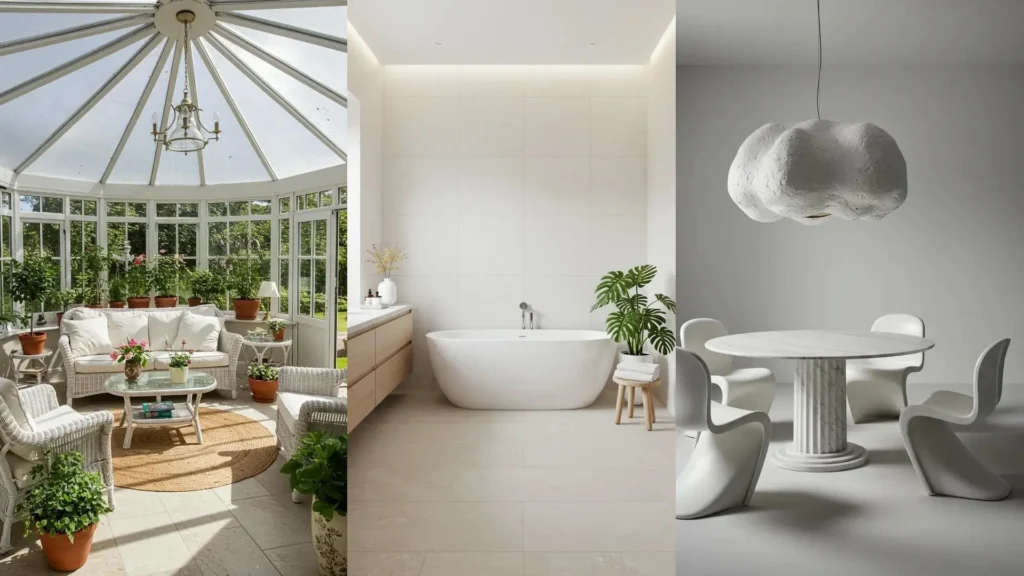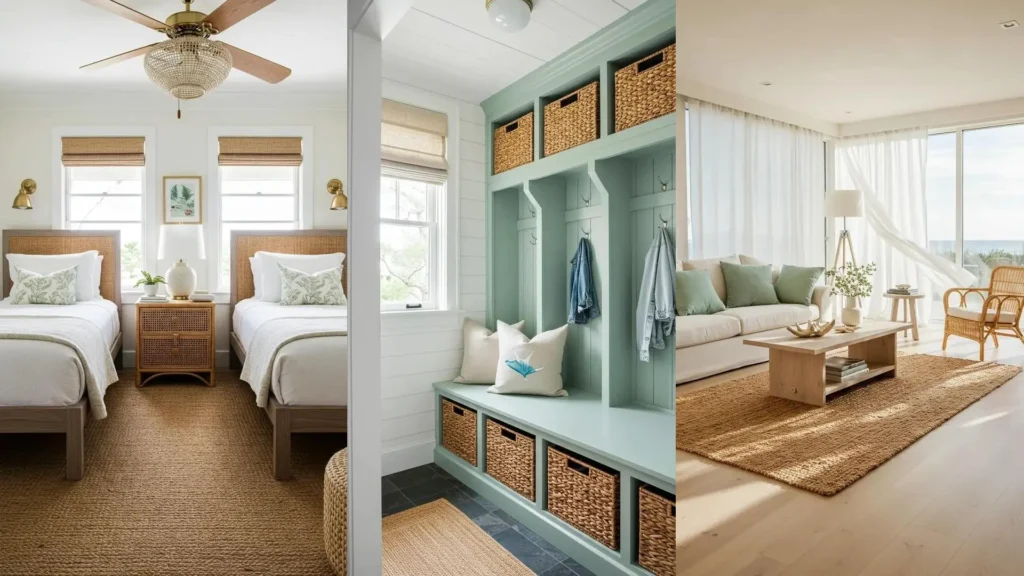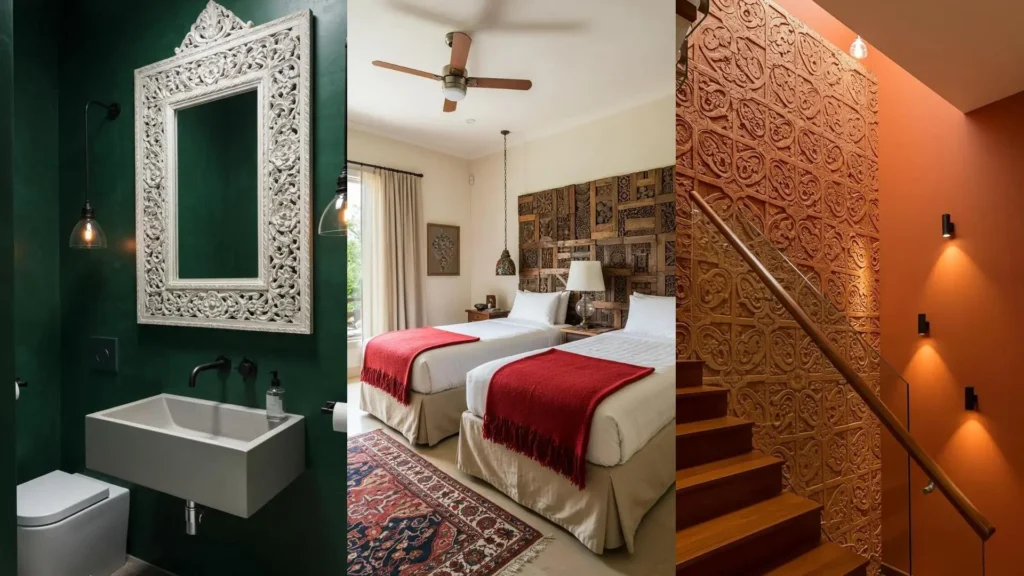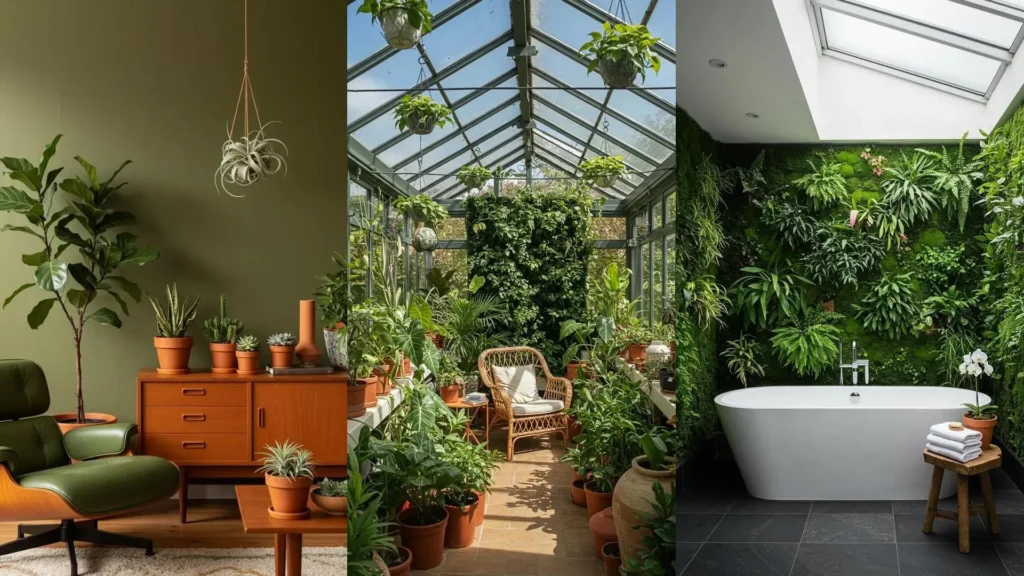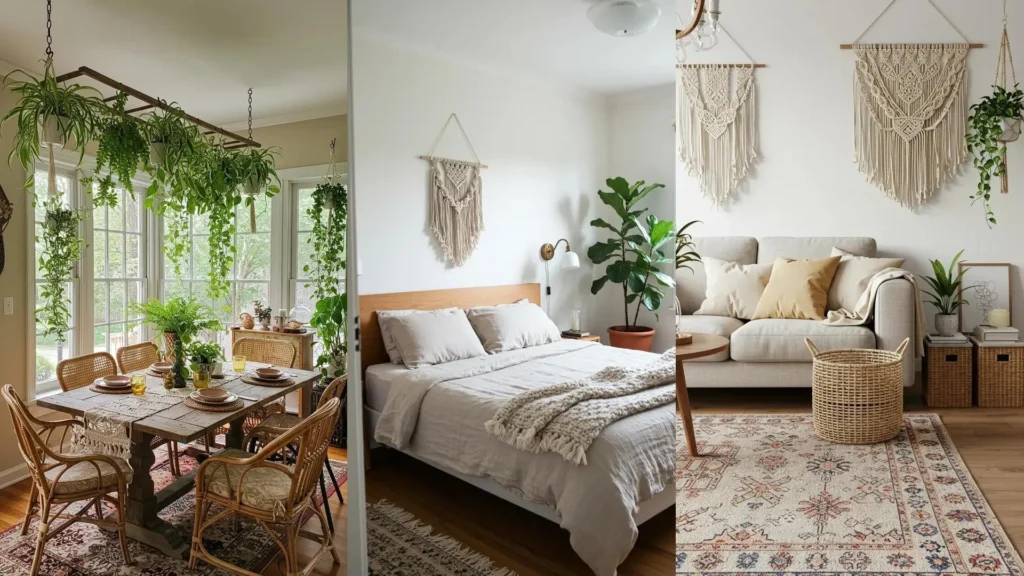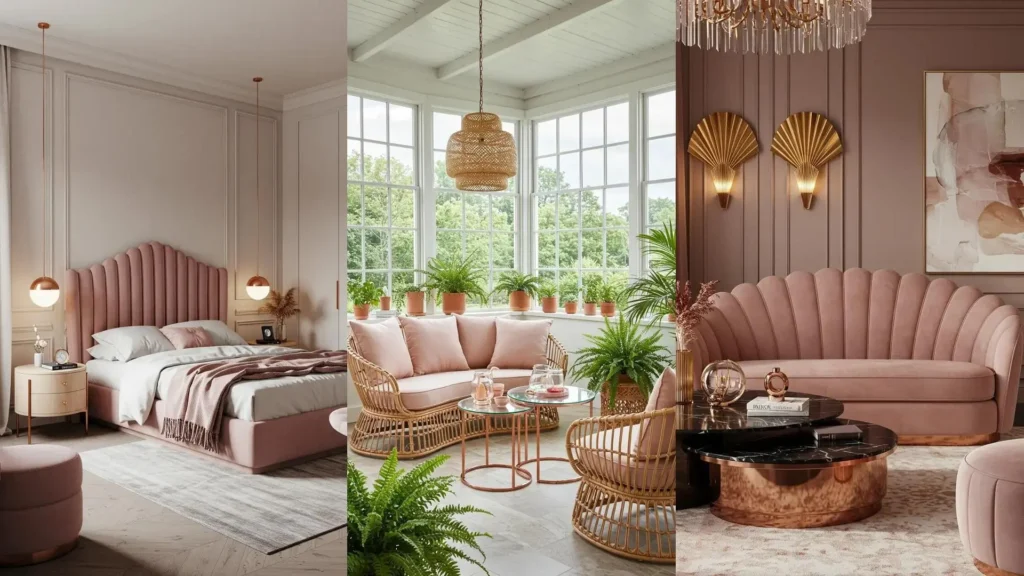An all-white interior is more than just a color choice; it’s a foundation for light, texture, and personal expression.
But how do you create a space that feels layered and soulful, not flat or cold? The secret lies in the subtleties—the contrast between rough and smooth, the play of light on different surfaces, and the intentional addition of natural, grounding elements.
This is your guide to mastering the art of the white interior. You’ll learn how to use texture to add warmth, how to choose furnishings that provide quiet contrast, and how to make natural light your most powerful design tool.
Your home can be a sanctuary of calm sophistication, and it starts here.
1. Ground Your Whites with Raw, Natural Textures
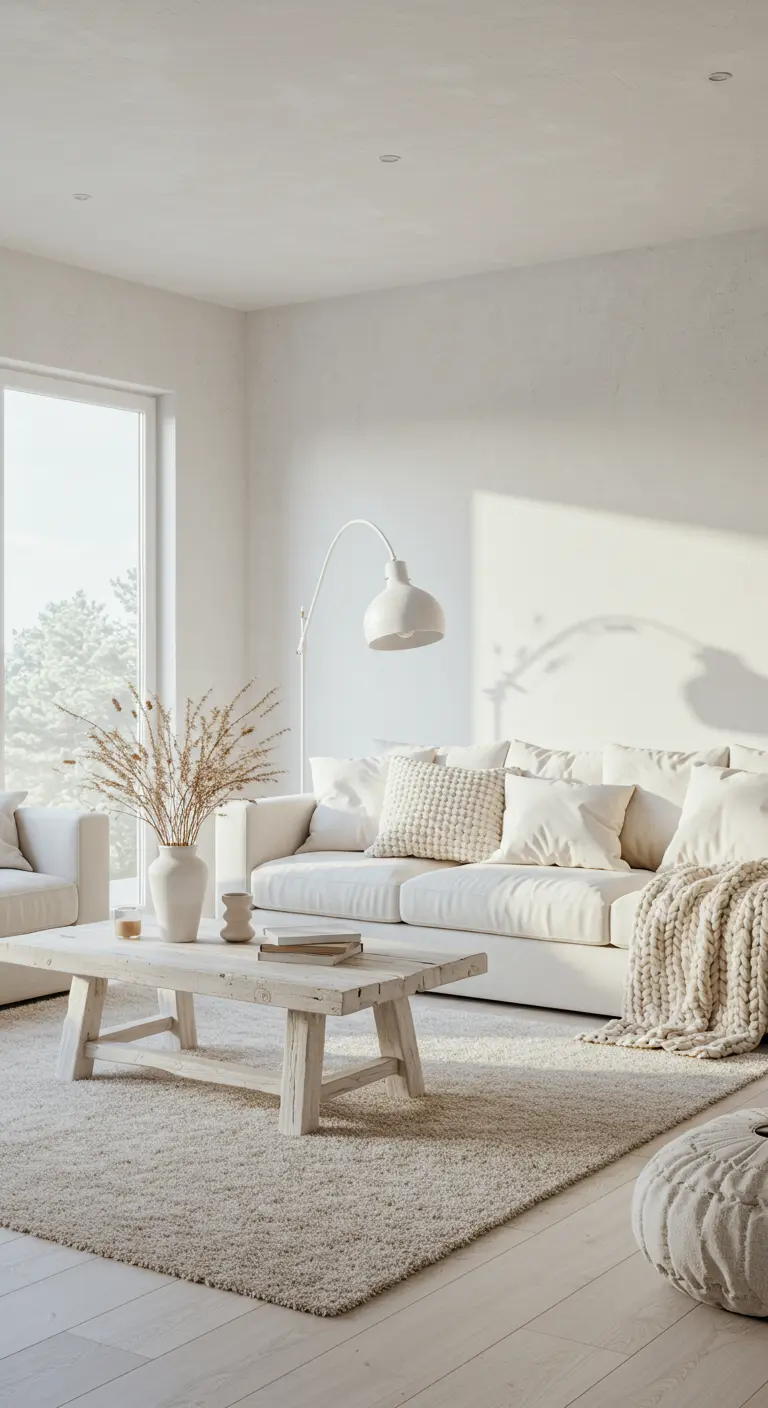
An all-white space feels grounded, not sterile, when you introduce substantial, earthy textures.
Notice how the low, rustic coffee table and the deep-pile rug add weight and warmth, preventing the sofa from floating in a sea of white.
You can achieve this by choosing one or two key pieces with a raw, unfinished quality, like a reclaimed wood table or a chunky hand-knit throw, to create a space that embraces the beauty of imperfection.
Dried botanicals like pampas grass or bunny tails are a soft, sculptural alternative to fresh flowers and require no upkeep.
2. Use Vertical Lines to Add Subtle Dimension
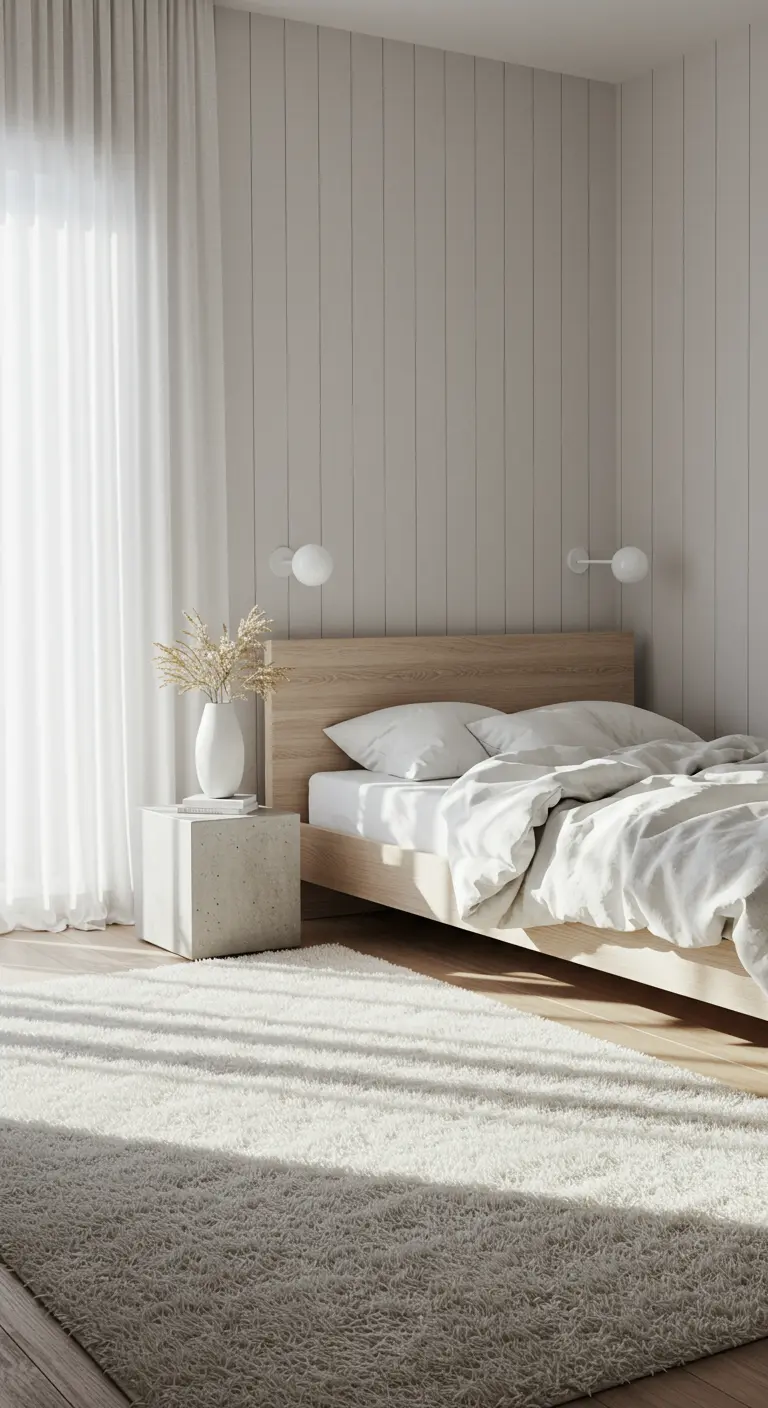
In a minimalist bedroom, texture can come from the walls themselves.
A simple vertical wood paneling, painted in a soft off-white, draws the eye upward and adds a sense of structure without overwhelming the space.
This is a powerful technique for rooms with standard ceiling heights, creating the illusion of more space.
Balance the clean lines of the wall with a high-pile shag rug to introduce softness underfoot, making the room feel instantly more inviting, much like in these light-filled romantic bedroom designs.
3. Elevate a White Kitchen with Polished Brass
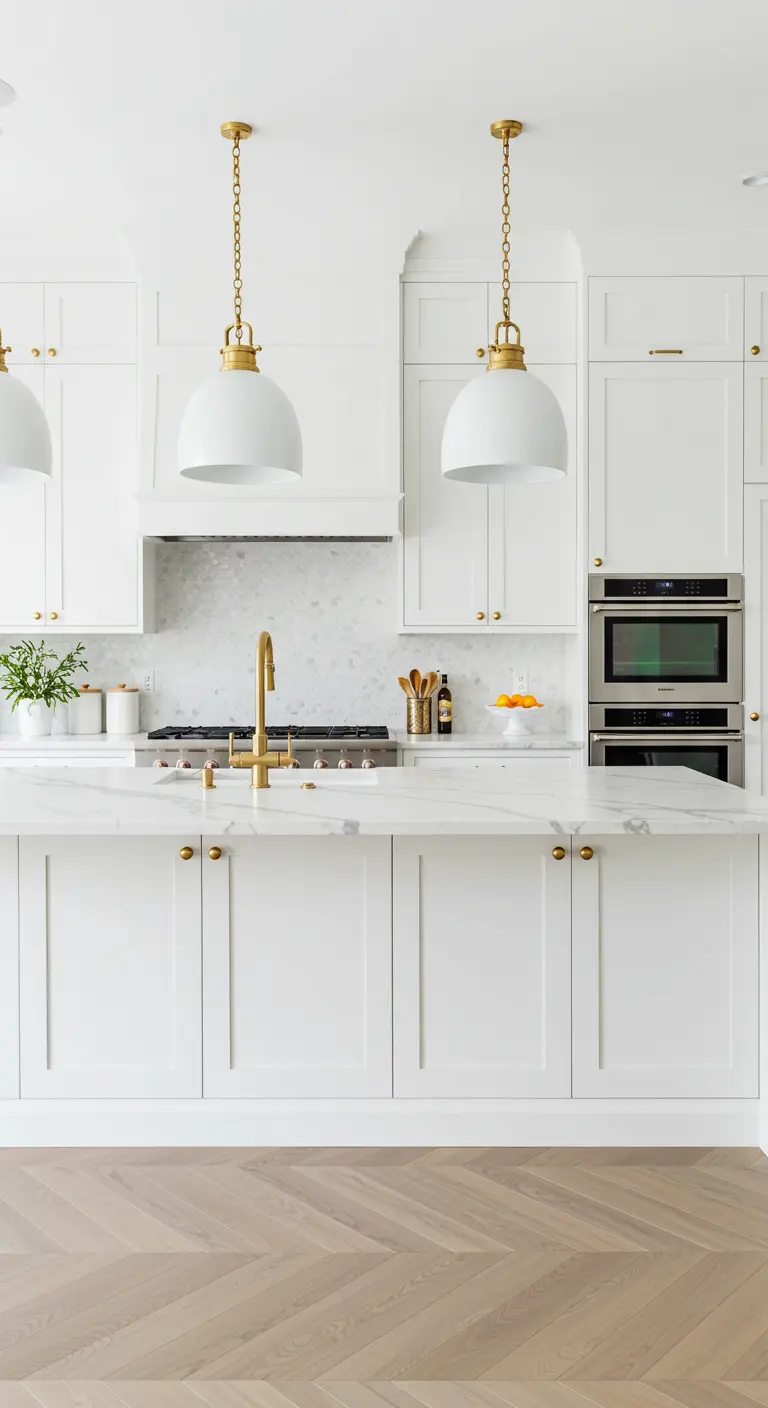
To give a classic white kitchen a dose of quiet glamour, switch out standard chrome or nickel hardware for brushed or polished brass.
The warmth of the metal acts as a subtle contrast against the crisp white cabinets and cool marble, creating a look that feels both timeless and current.
Coordinate your cabinet pulls, faucet, and pendant lighting for a cohesive, high-end feel.
Notice how the chain detail on the pendants adds an extra layer of texture and interest, an upgrade that contributes to a luxurious kitchen atmosphere.
4. Soften Modern Lines with Woven Details

A minimalist dining set can feel stark, but introducing natural, woven textures instantly adds warmth and approachability.
These classic cane chairs provide a beautiful organic contrast to the sleek lines of the white table and polished floor.
The paper lantern pendant light reinforces this idea, diffusing a soft, gentle glow that makes the space feel more intimate.
This combination proves that minimalism can be warm and soulful, not cold.
5. Warm a Spa Bathroom with Natural Wood Tones
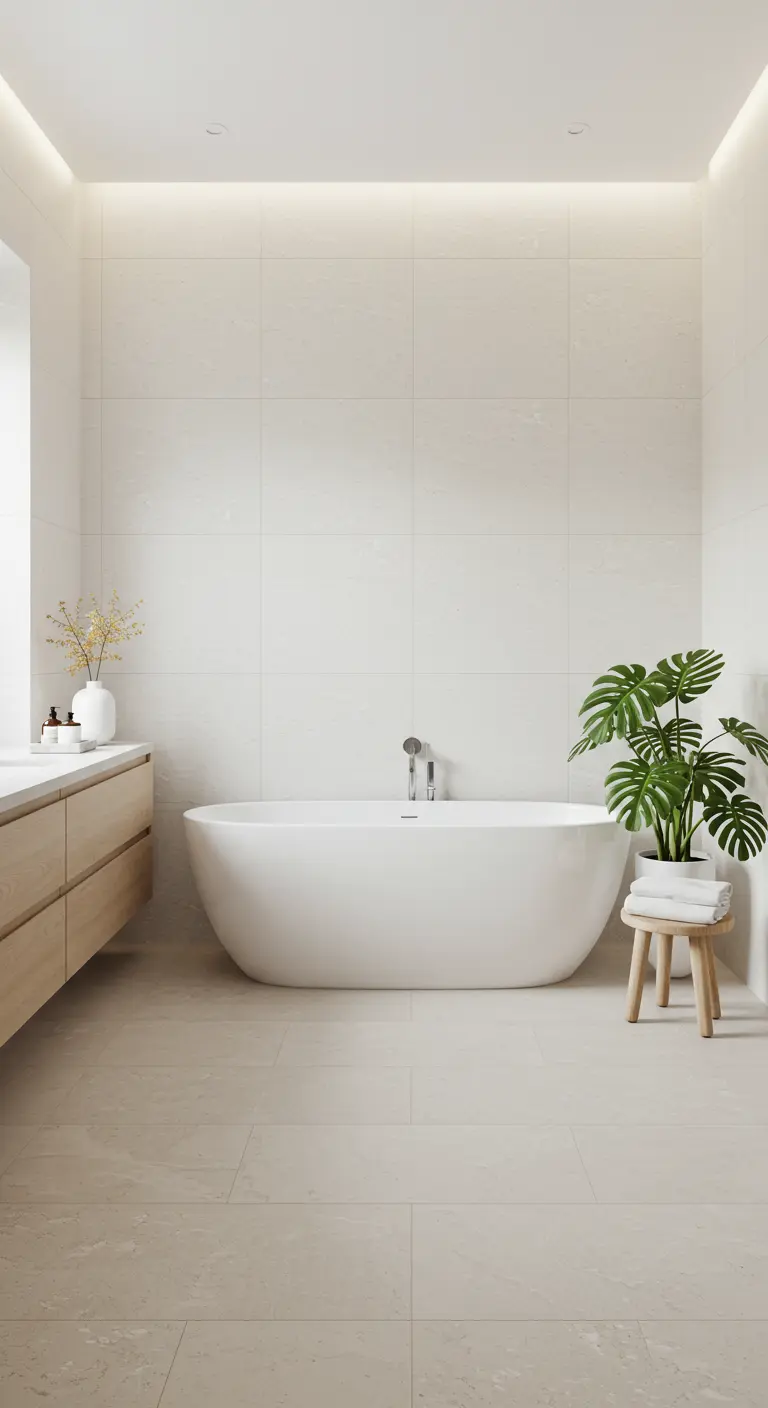
In a tiled, all-white bathroom, a touch of natural wood can prevent the space from feeling clinical.
A floating wood vanity introduces an organic element that feels both clean and grounding.
Pair it with a simple potted plant, like this Monstera, to add life and a touch of vibrant, natural color.
The concealed cove lighting above the tiles is a brilliant touch, washing the wall in a soft glow and turning your bathroom into a true spa-like retreat.
6. Layer Tone-on-Tone Texture for a Quiet Workspace
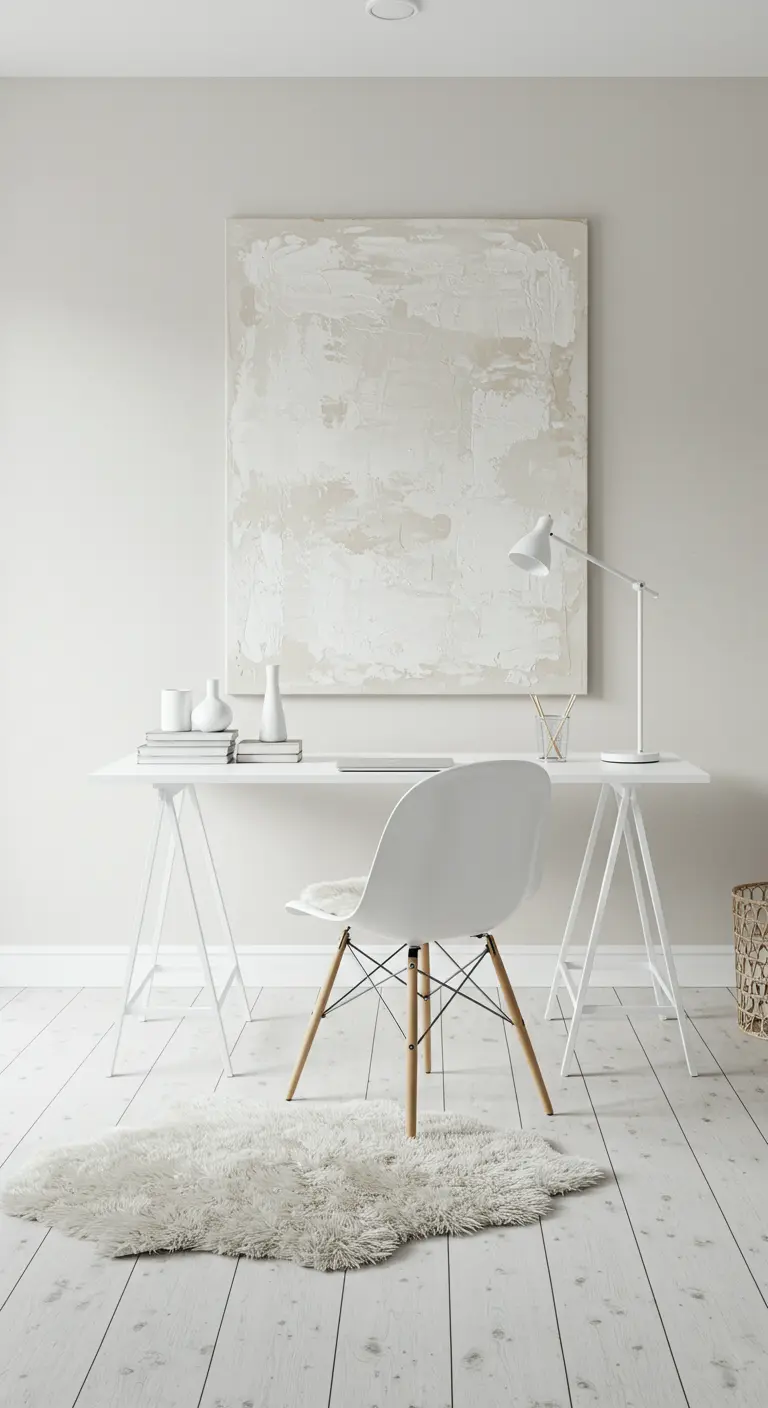
A productive home office doesn’t need color to feel inspiring. Instead, focus on layered, tone-on-tone textures.
The heavily textured plaster-style canvas creates a focal point without introducing a distracting hue. You can DIY a similar piece with joint compound on a plain canvas.
A small sheepskin rug adds a touch of luxurious softness underfoot, a simple upgrade that makes a significant difference in your daily comfort.
These elements create a calm, focused environment that is visually rich yet utterly serene, perfect for even the most compact of office nooks.
7. Balance Industrial Bones with Soft Furnishings

If you have strong architectural features like exposed brick or beams, painting them white unifies the space and becomes a textural backdrop.
Contrast the roughness of the painted brick and industrial windows with deeply comfortable, soft furnishings.
A low-profile, oversized sectional sofa and a plush, tufted ottoman invite relaxation and soften the room’s hard edges.
This high-contrast play between rough and smooth, hard and soft, is the key to making a loft feel like a welcoming home.
8. Anchor a Sunroom with an Earthy Jute Rug
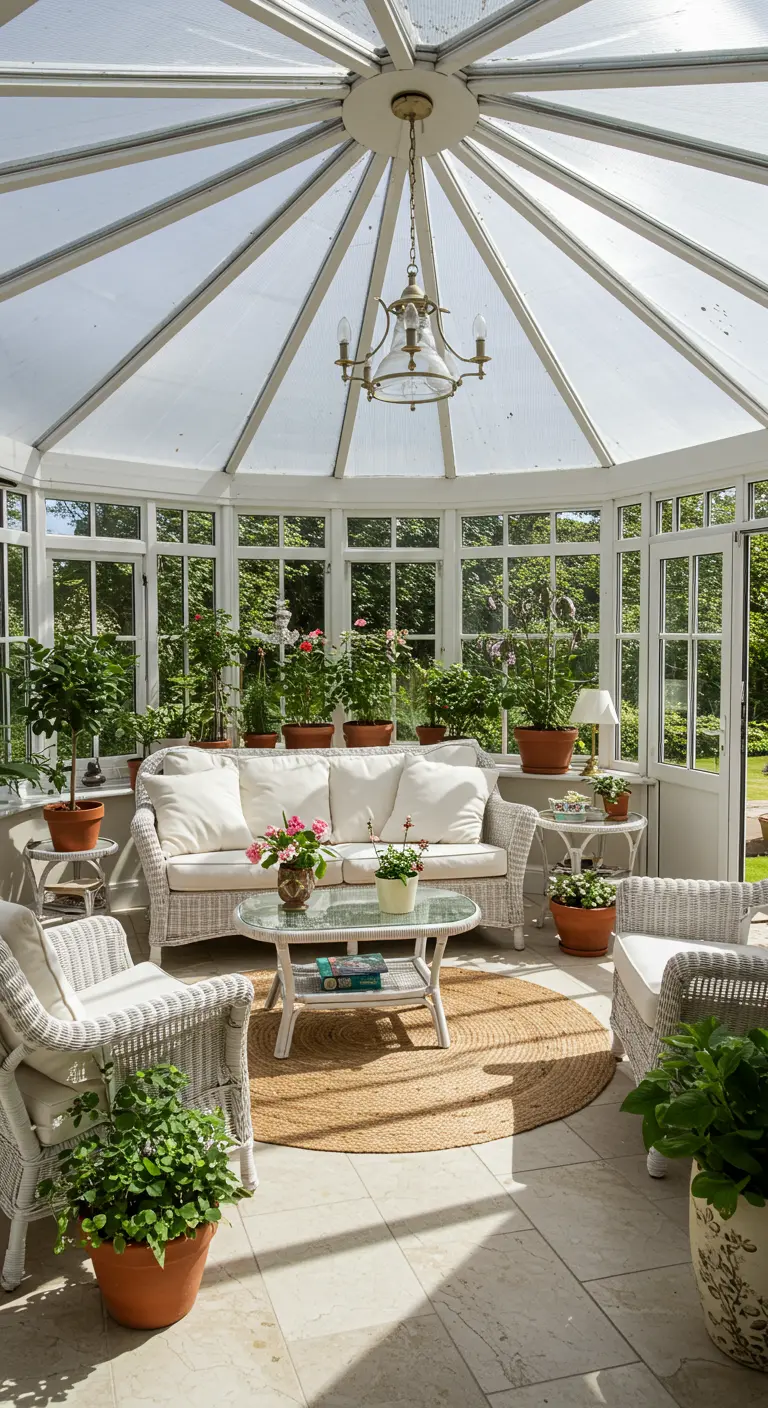
In a light-drenched space like a conservatory or sunroom, a natural fiber rug is essential for grounding the design.
A circular jute or sisal rug defines the seating area and adds an earthy, textural element that connects the indoor space with the garden beyond.
Classic white wicker furniture keeps the look airy and light, perfect for a room designed to embrace the sun.
Lush green plants in simple terracotta pots are the only color you need, turning the space into a beautiful green retreat.
9. Set a Serene Tone with Sculptural Shapes
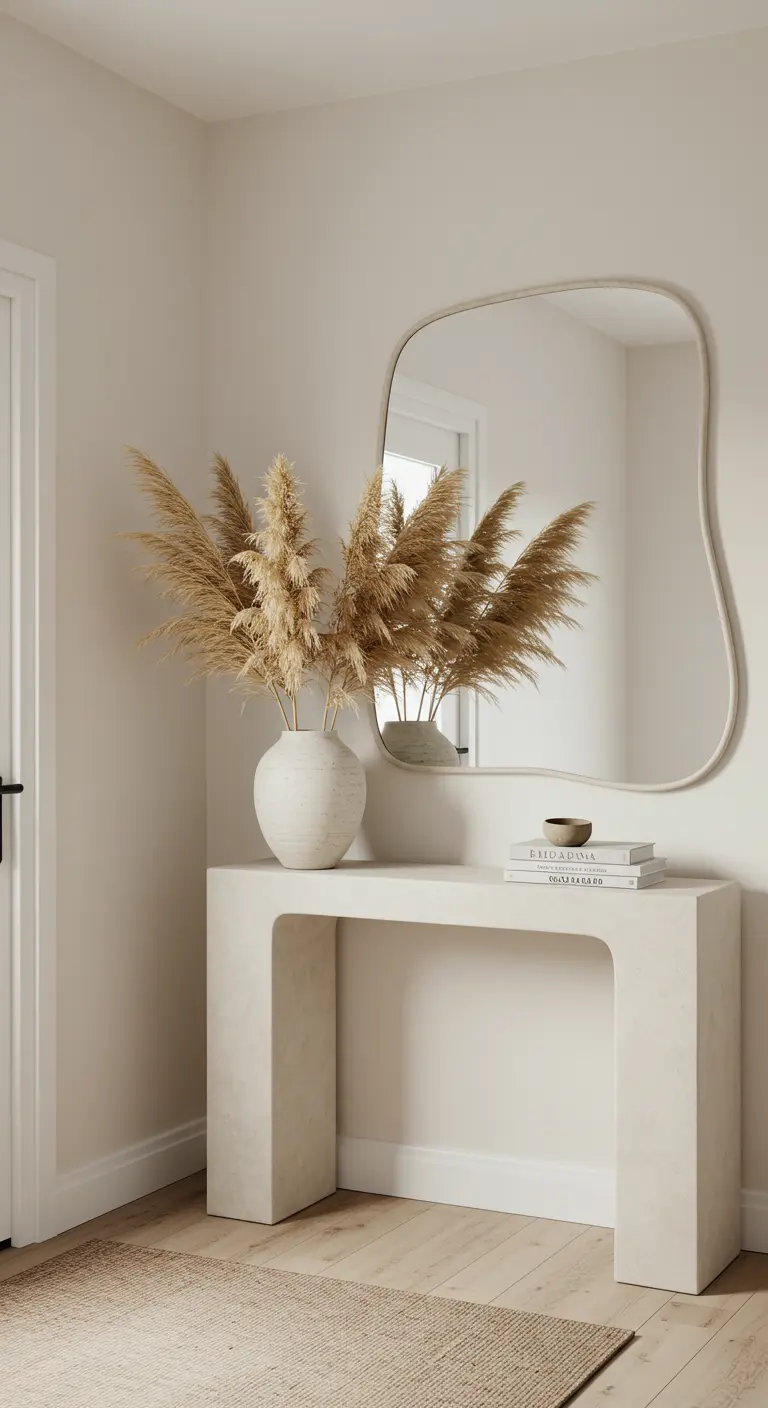
Your entryway is the first impression of your home, so establish a calm, curated feel from the start.
Choose pieces with soft, sculptural forms, like this waterfall console table and amoeba-shaped mirror.
The plaster or stone-like finish on the table adds a beautiful, artisanal quality that feels both ancient and modern.
A simple arrangement of pampas grass is all the styling needed to complete this refined, minimalist vignette.
10. Carve Out a Cozy Nook with Texture and Task Lighting

Transform any small corner into an irresistible reading nook by focusing on comfort and function.
A built-in bench becomes instantly inviting with plush cushions and an extravagantly chunky knit throw for ultimate coziness.
Practicality is just as important. An articulating wall sconce provides focused light exactly where you need it, and its dark finish adds a welcome point of contrast.
This shows how even the smallest alcoves can become the most beloved cozy corners in the house.
11. Introduce a Single Point of Black for Definition
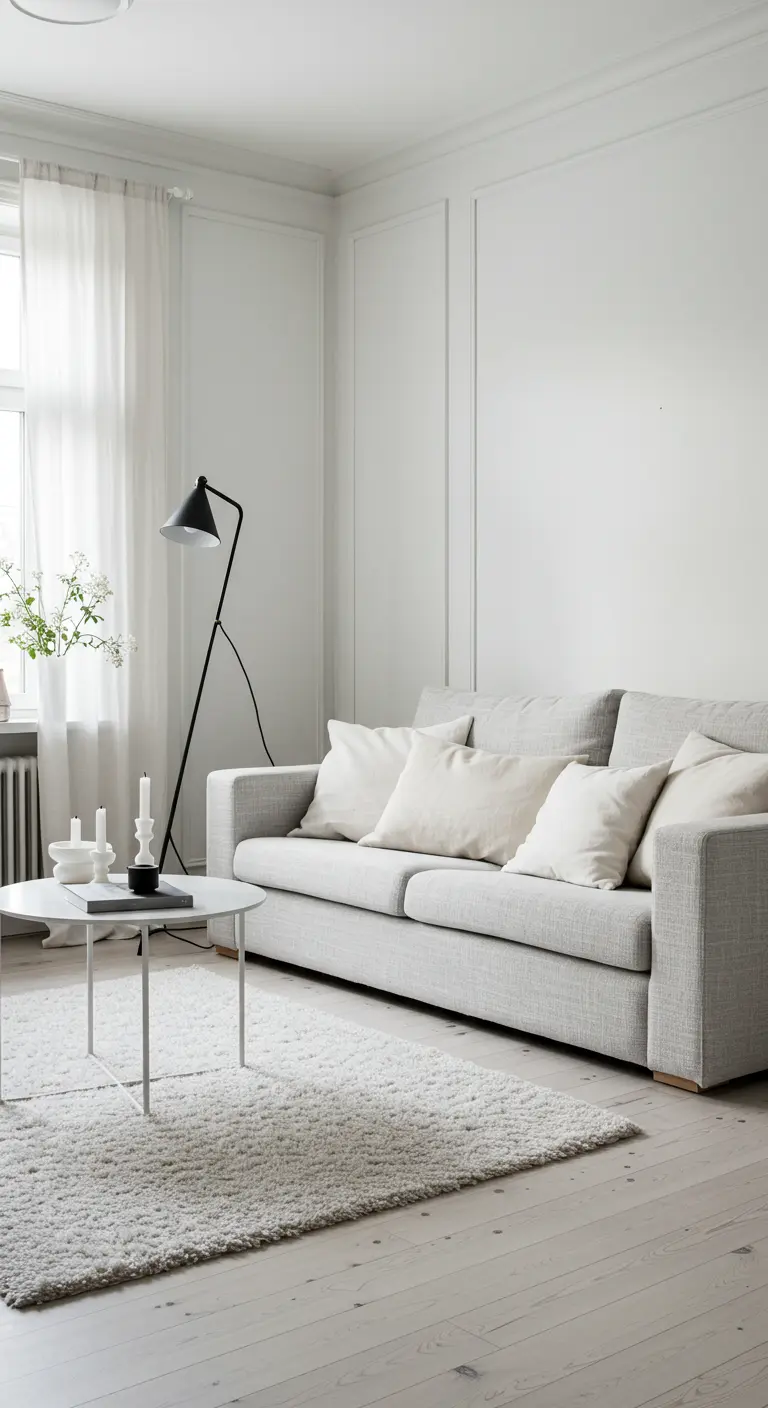
In a pale, Scandinavian-inspired space, a single, well-placed black element can work wonders.
The slim, black tripod floor lamp provides a graphic accent that anchors the room and prevents the whites and grays from blending together.
It’s a small touch that adds structure and sophistication without disrupting the room’s serene, airy quality.
This chic, minimalist approach pairs a light gray sofa with white walls for a soft, low-contrast look that feels calm and layered.
12. Bring in a Piece of the Coast
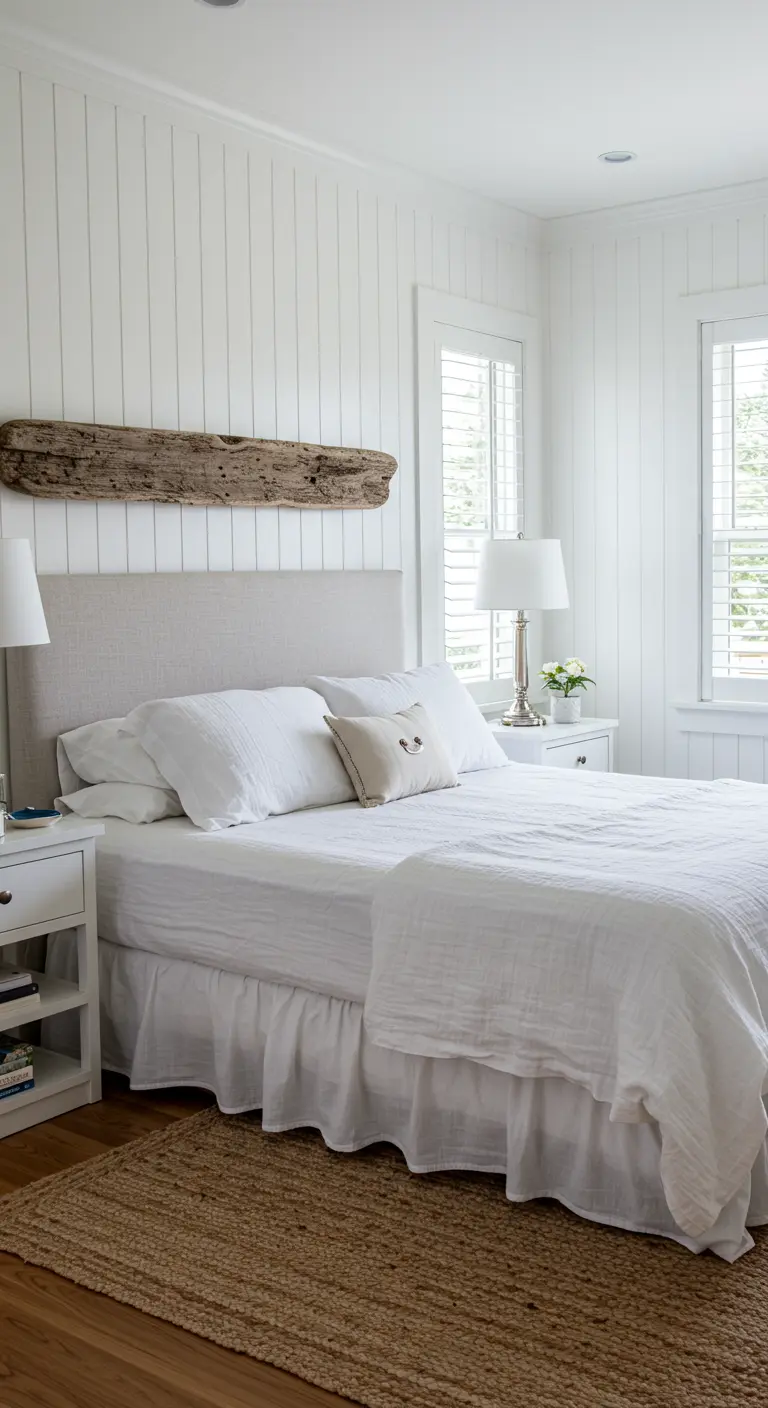
Evoke a serene, coastal feeling without resorting to clichés by using authentic, natural materials.
A piece of weathered driftwood mounted above the bed acts as a unique, sculptural headboard and a powerful natural focal point.
The texture of the wood is complemented by a simple jute rug underfoot and crisp white linens on the bed.
This approach creates a subtle, sophisticated coastal vibe that feels calming and deeply connected to nature.
13. Embrace Imperfection with Plaster and Raw Wood
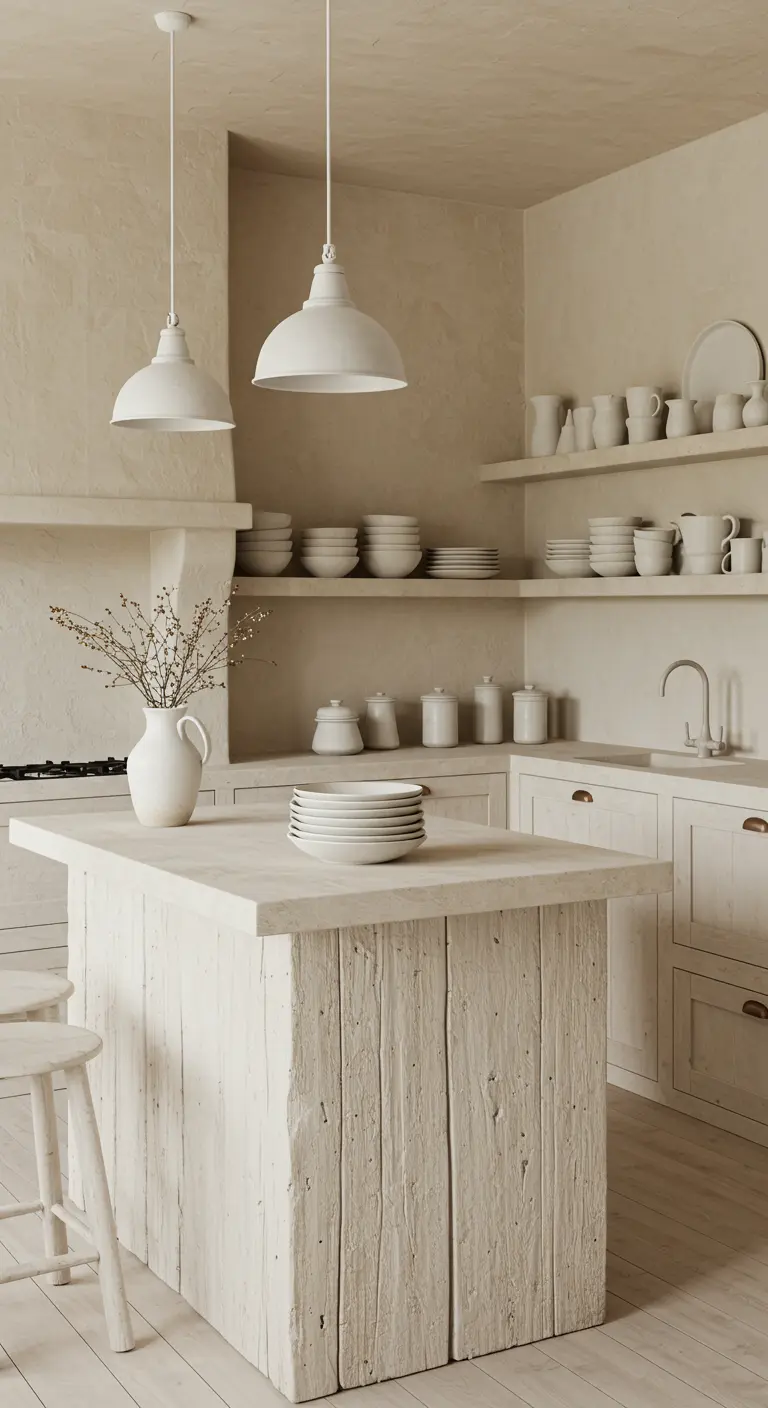
Move away from high-gloss perfection and embrace the beauty of raw, imperfect materials.
Limewash or plaster-finished walls provide a soft, chalky texture that diffuses light beautifully, creating a warm, enveloping feel.
A kitchen island clad in rough, reclaimed wood becomes the heart of the room, its ruggedness contrasting with the smoothness of the ceramic dinnerware.
This approach results in a space that feels soulful, personal, and timeless, much like these rooms decorated in warm earth tones.
14. Mix Distressed Finishes with Natural Wood
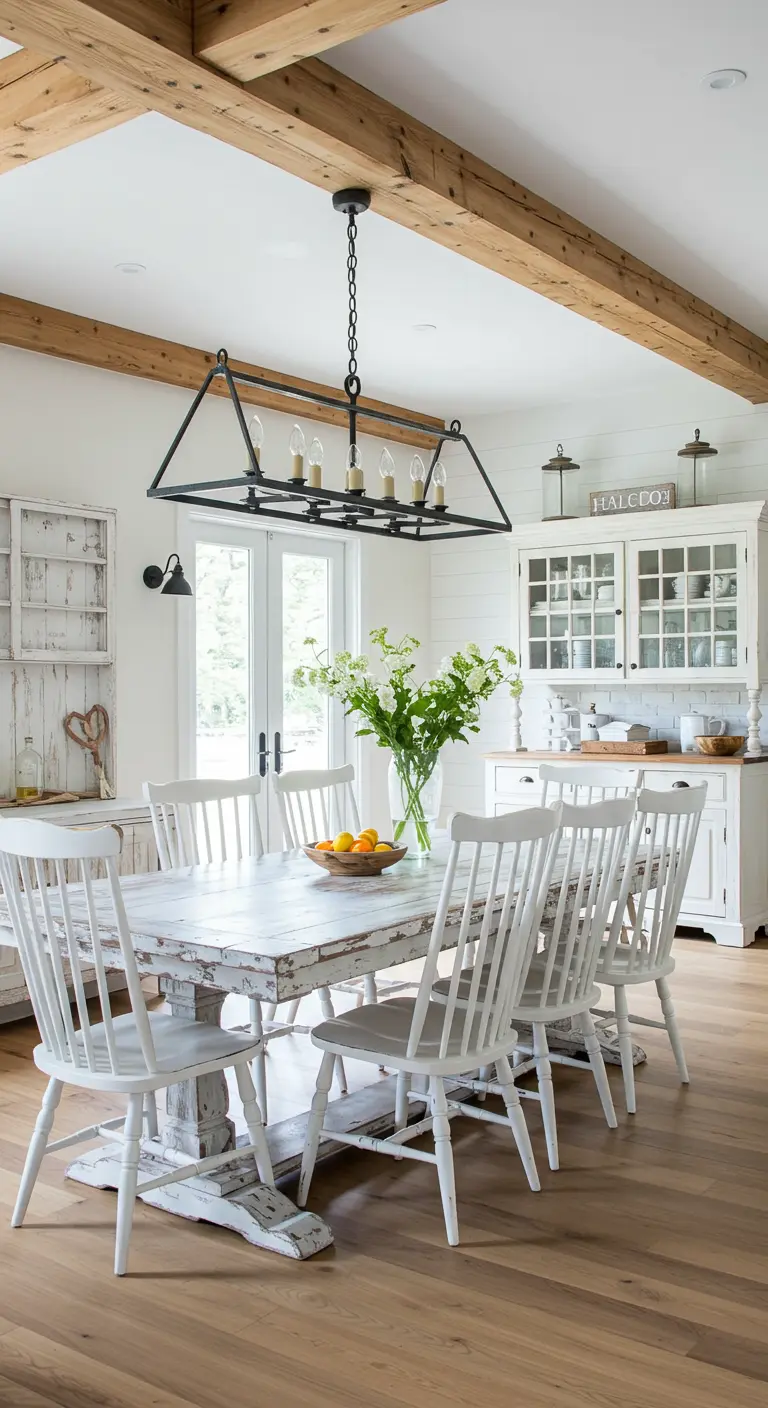
Achieve a modern farmhouse look by balancing painted and natural wood finishes.
Here, the warm, natural wood of the ceiling beams provides a rich contrast to the distressed white paint of the dining table and hutch.
This intentional mix prevents the room from feeling too matched or theme-heavy, adding a layer of authenticity.
A simple black iron chandelier grounds the space and ties in with the classic modern farmhouse aesthetic.
15. Filter Light Beautifully with Shoji Screens
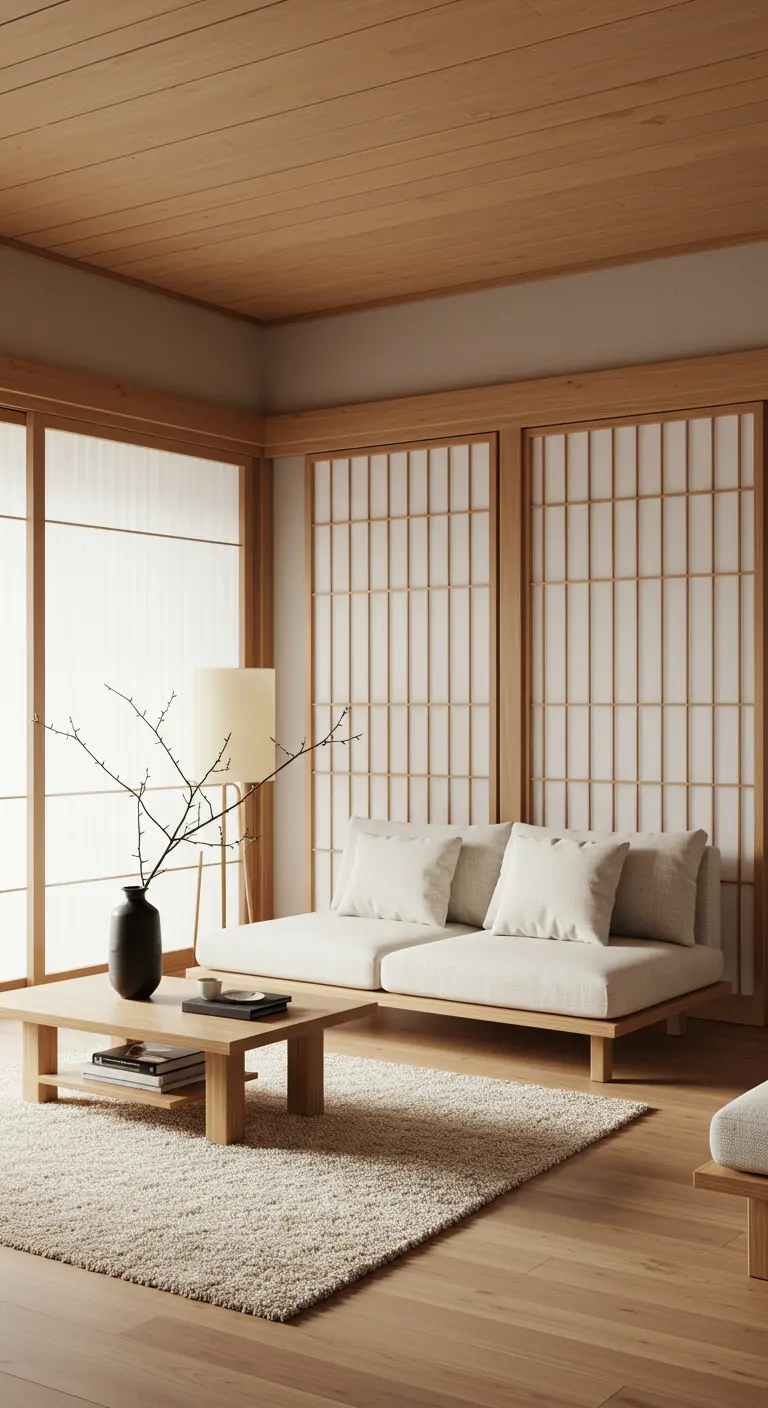
For a space that feels both open and private, look to the elegance of Japanese design.
Shoji screens are a brilliant solution for dividing a room or covering windows, as their translucent paper diffuses daylight into a soft, ethereal glow.
The simple wood grid adds a delicate architectural pattern, creating visual interest without clutter.
Pair them with low-profile furniture and a natural fiber rug to complete the serene, Japandi-inspired aesthetic.
16. Design for an Abundance of Natural Light
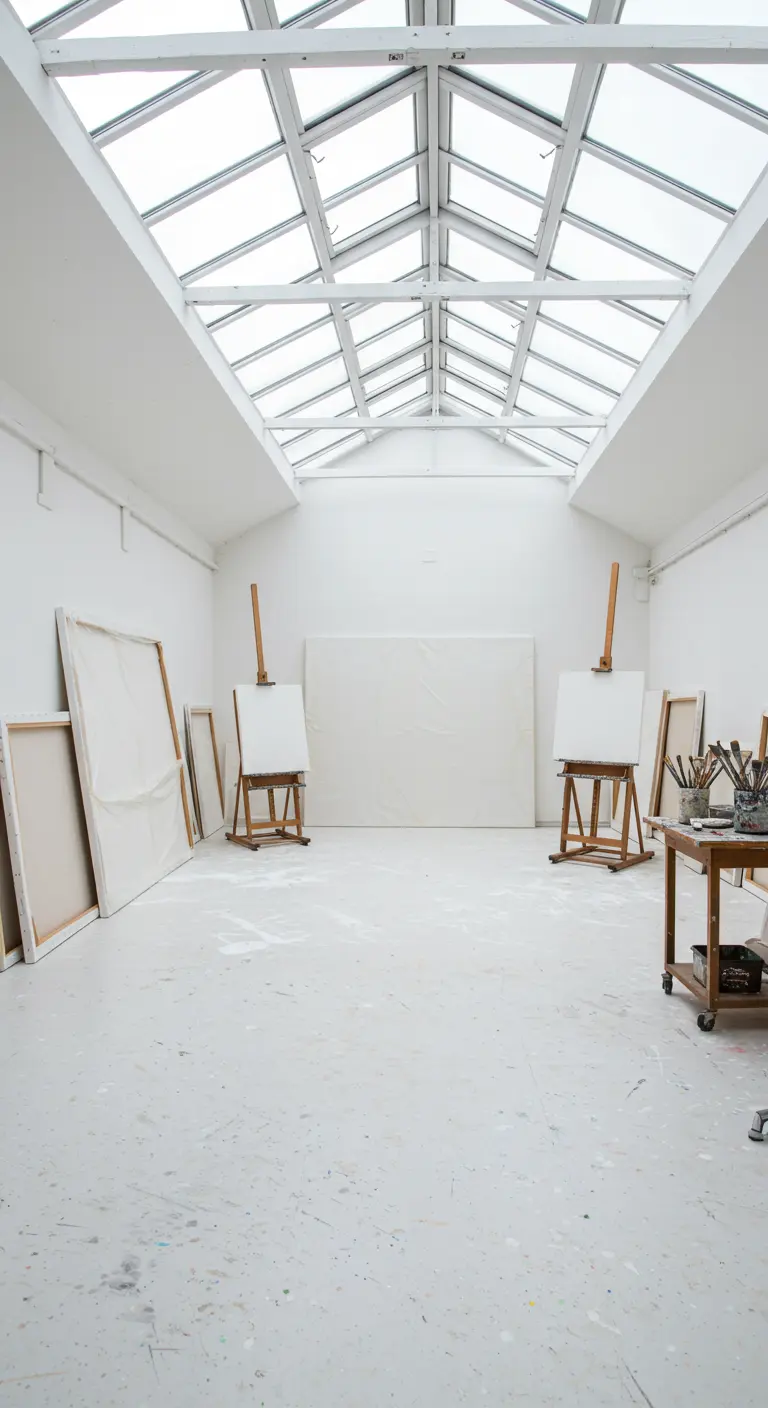
When your goal is a pure, creative space, nothing is more important than natural light.
A large skylight floods this all-white studio with clear, consistent light, essential for creative work and for making the space feel expansive.
Keeping the walls, floor, and ceiling a uniform white allows the light to bounce freely, eliminating shadows and creating a blank canvas for inspiration.
While this is an artist’s studio, the principle applies to any room where you want to make small spaces feel larger and more open.
17. Turn an Attic into a Bright, Cozy Haven
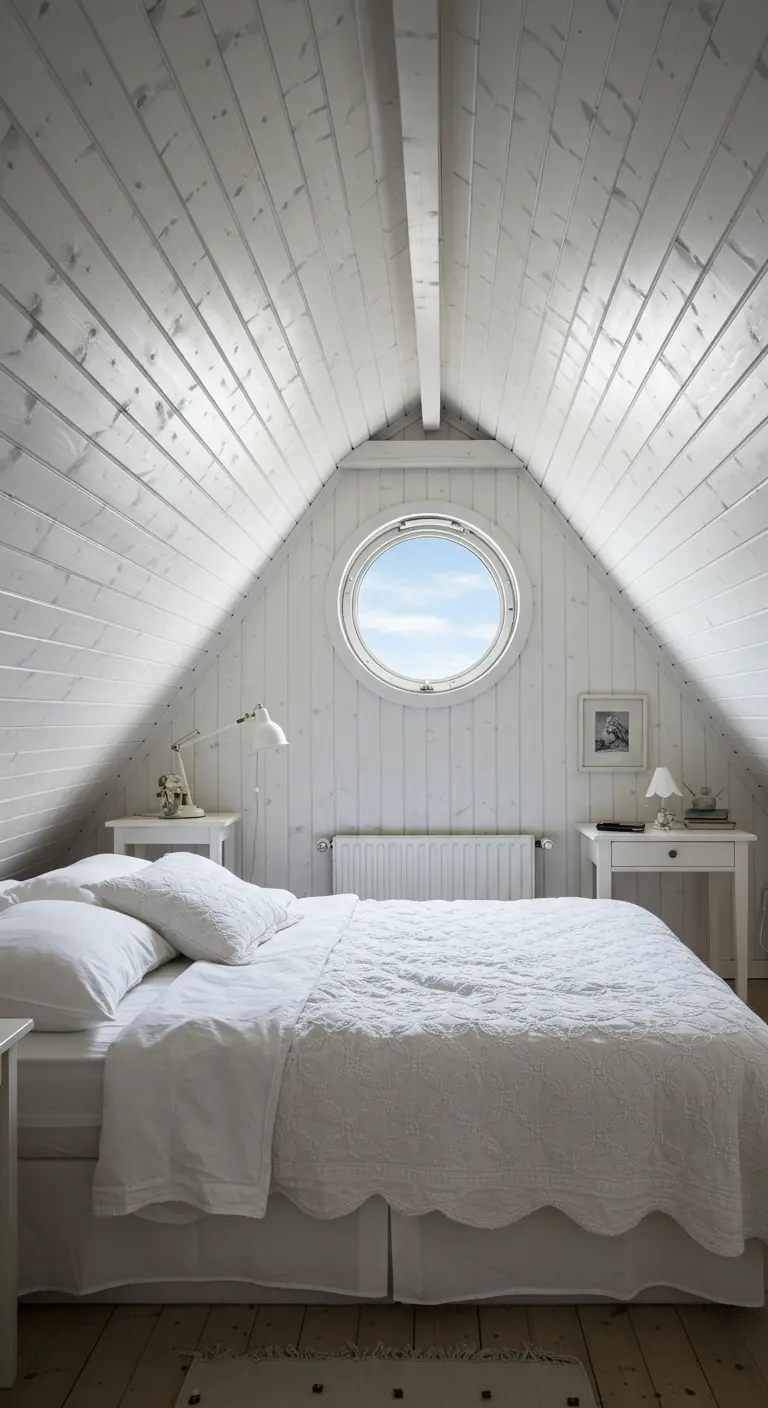
Embrace the unique architecture of an attic by painting everything—walls, ceiling, and beams—the same shade of white.
This technique visually pushes back the angled walls, making a small or awkwardly shaped room feel larger and more cohesive.
A round porthole window becomes a charming focal point, adding character and a view of the sky.
Layer white-on-white textiles with different textures, like the embroidered quilt here, to add the depth and coziness found in charming cottage-core nooks.
18. Use Glass and Wood for a Minimalist Look
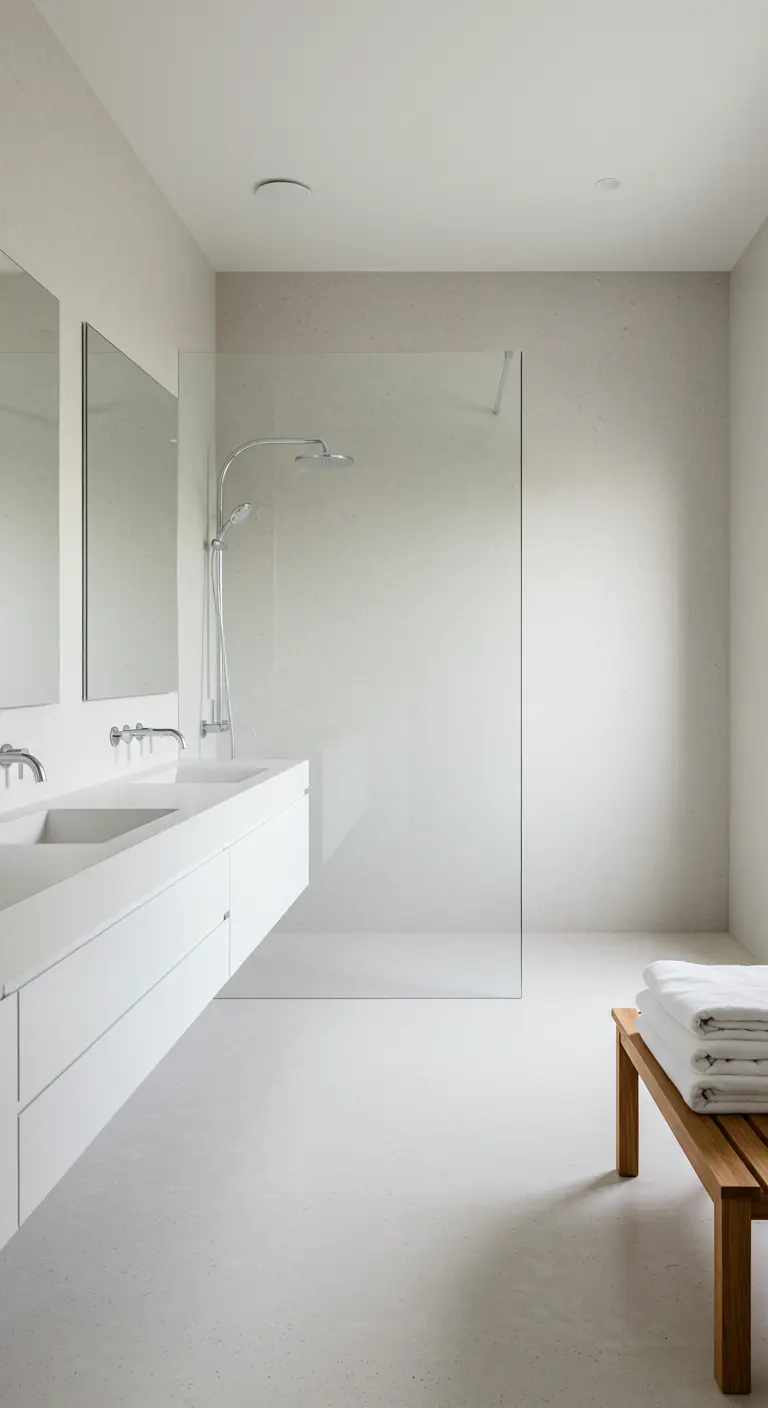
Achieve a seamless, ultra-clean look in your bathroom by eliminating visual barriers.
A single, frameless glass panel for the shower is far less obtrusive than a traditional enclosure, making the entire room feel like one continuous space.
Paired with wall-mounted fixtures and a floating vanity, the floor is left clear, enhancing the sense of spaciousness.
A simple teak bench adds a necessary touch of warmth, proving that even the most ultra-modern designs need an organic touch.
19. Create a Calm Nursery with Soft Textures
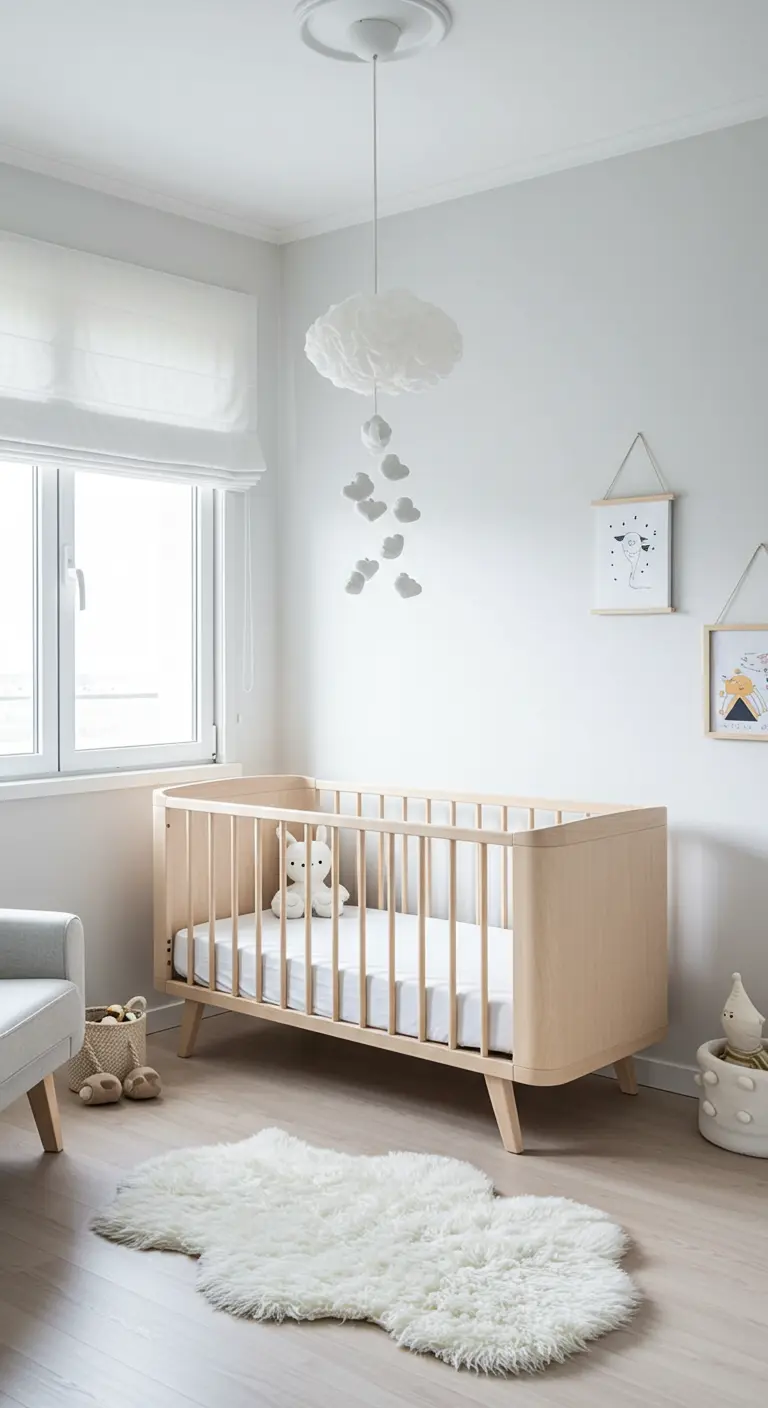
A nursery should be a place of serenity for both you and your baby. A soft, neutral palette is the perfect foundation.
Combine light-toned wood, like the crib and flooring, with creamy whites for a gentle, soothing atmosphere.
Introduce ultra-soft textures through a plush sheepskin rug and a whimsical cloud mobile, embracing the cozy feeling of Scandinavian hygge.
These tactile elements provide gentle sensory stimulation, and the calm backdrop allows for personal touches to be added over time without ever feeling cluttered.
20. Integrate a Sculptural, Modern Fireplace
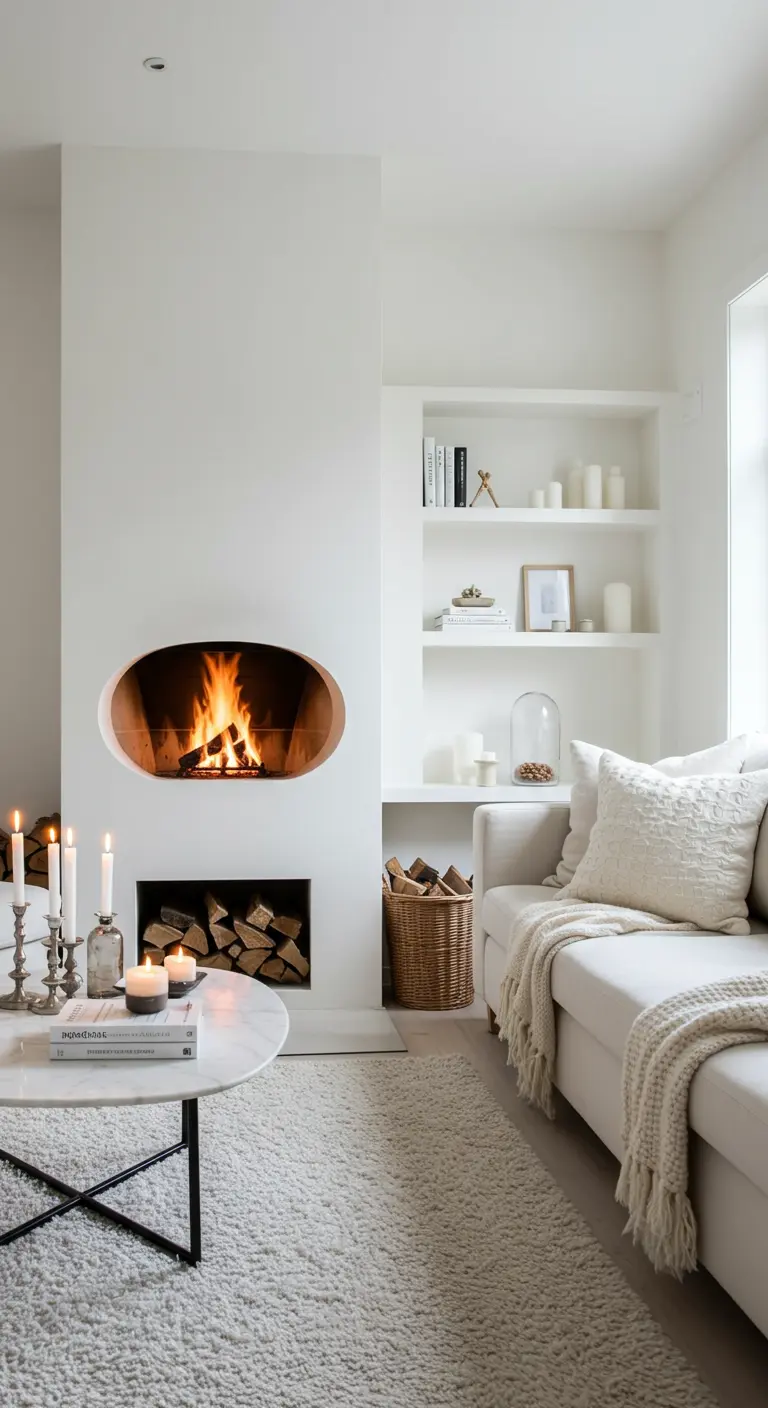
Reimagine the fireplace not as a traditional centerpiece, but as an integrated piece of modern sculpture.
This smooth, recessed fireplace with its soft oval opening is a stunning minimalist statement.
By surrounding it with clean, white walls and simple built-in shelving, the focus remains on the elegant form and the warmth of the fire itself.
Notice how the logs are stored in a simple, clean-lined niche below, maintaining the uncluttered aesthetic of a warm, modern interior.
21. Soften a Kitchen with Curved Furniture
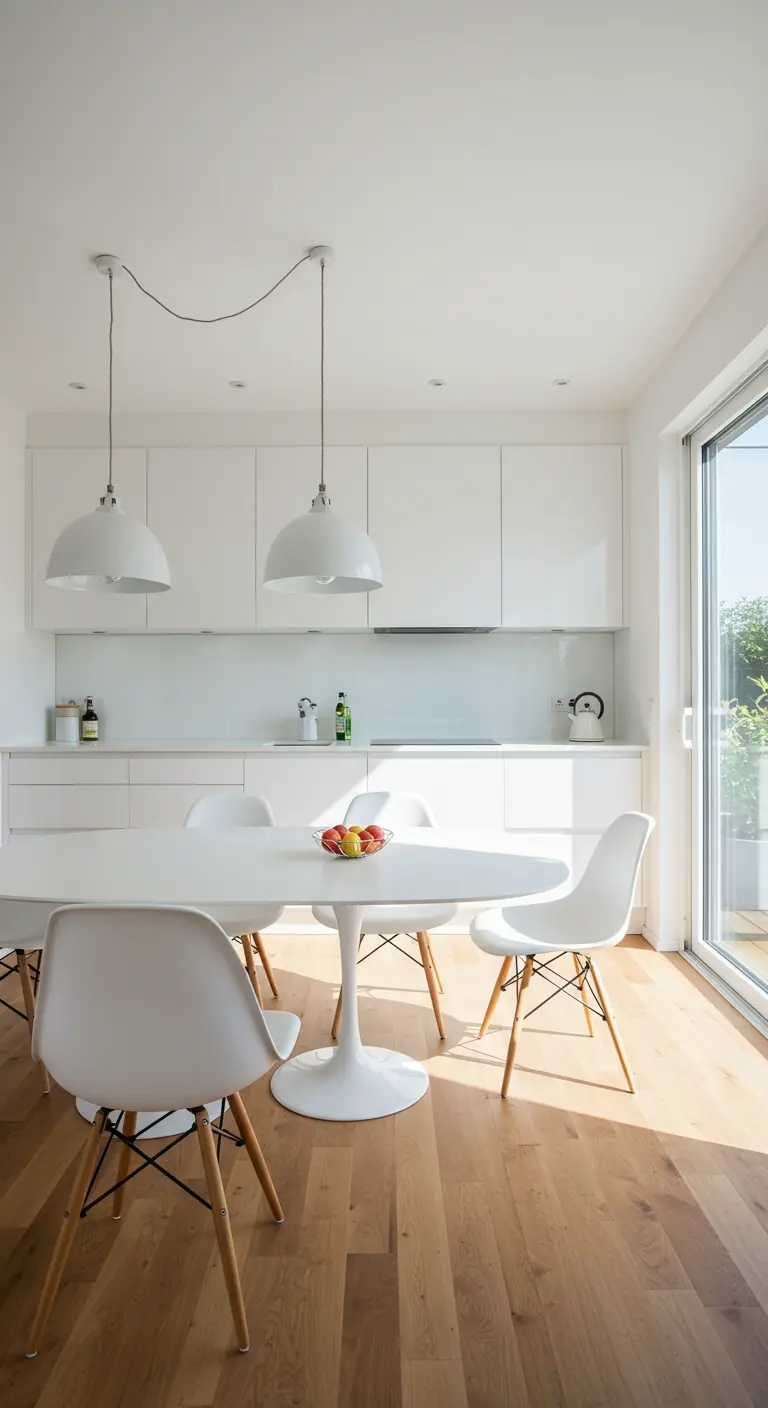
In a room defined by the hard lines of cabinetry and countertops, introducing curves can dramatically soften the overall feel.
An oval dining table and classic mid-century modern chairs with rounded backs break up the straight lines of the kitchen, creating a more fluid and inviting dining area.
The gentle swag of the pendant light cord is another subtle way to add a graceful curve to the space.
This is a simple layout trick that makes a small dining corner feel more generous and sociable.
22. Create a Gallery of Textural, Monochrome Art
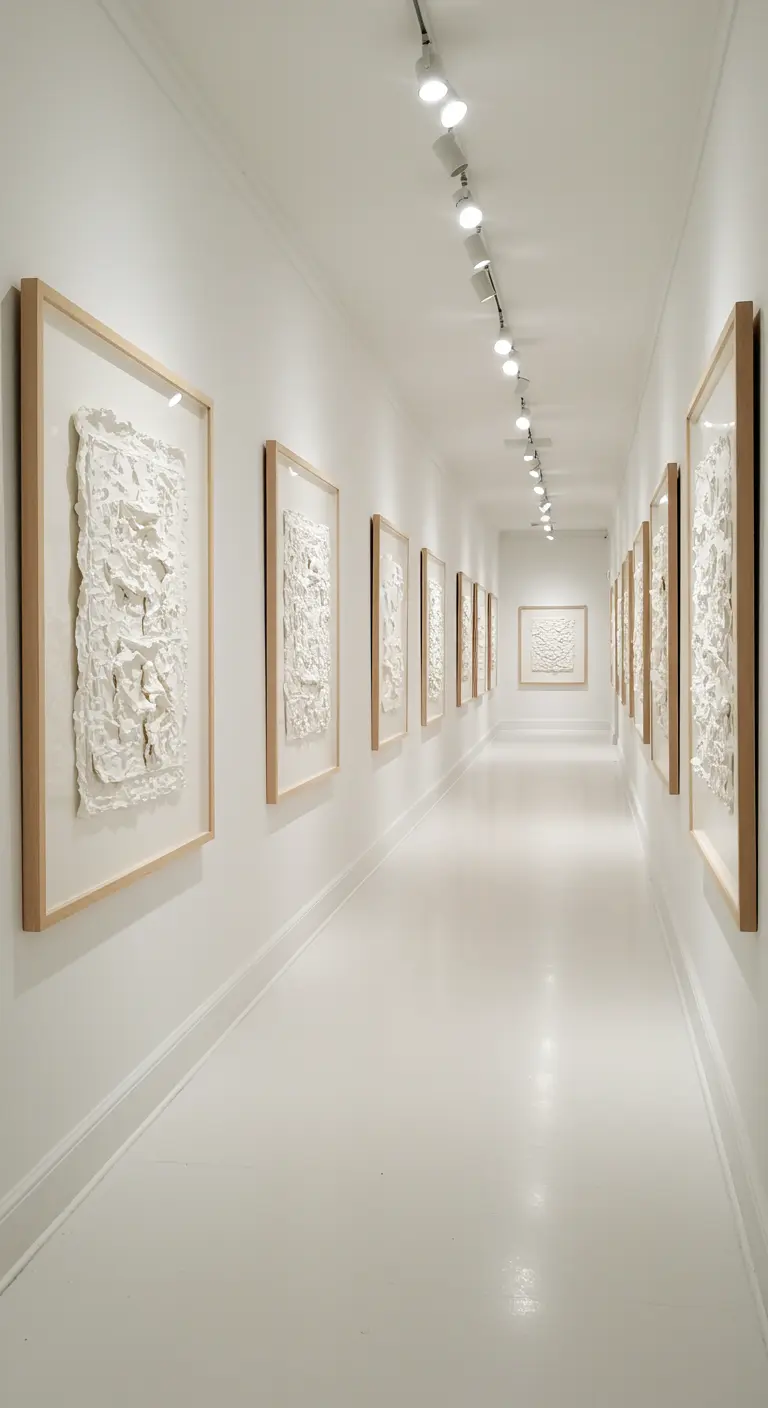
A gallery wall doesn’t need to be about color to make a statement.
Create a sophisticated, high-impact gallery by focusing entirely on white, three-dimensional art.
The deep texture of these plaster-like pieces catches the light, creating a beautiful play of shadows that changes throughout the day.
Simple, light wood frames provide just enough definition without competing with the art. It’s an elegant way to use gallery wall layouts to add depth to a simple hallway.
23. Layer Woven and Gauzy Textures for a Boho Dream
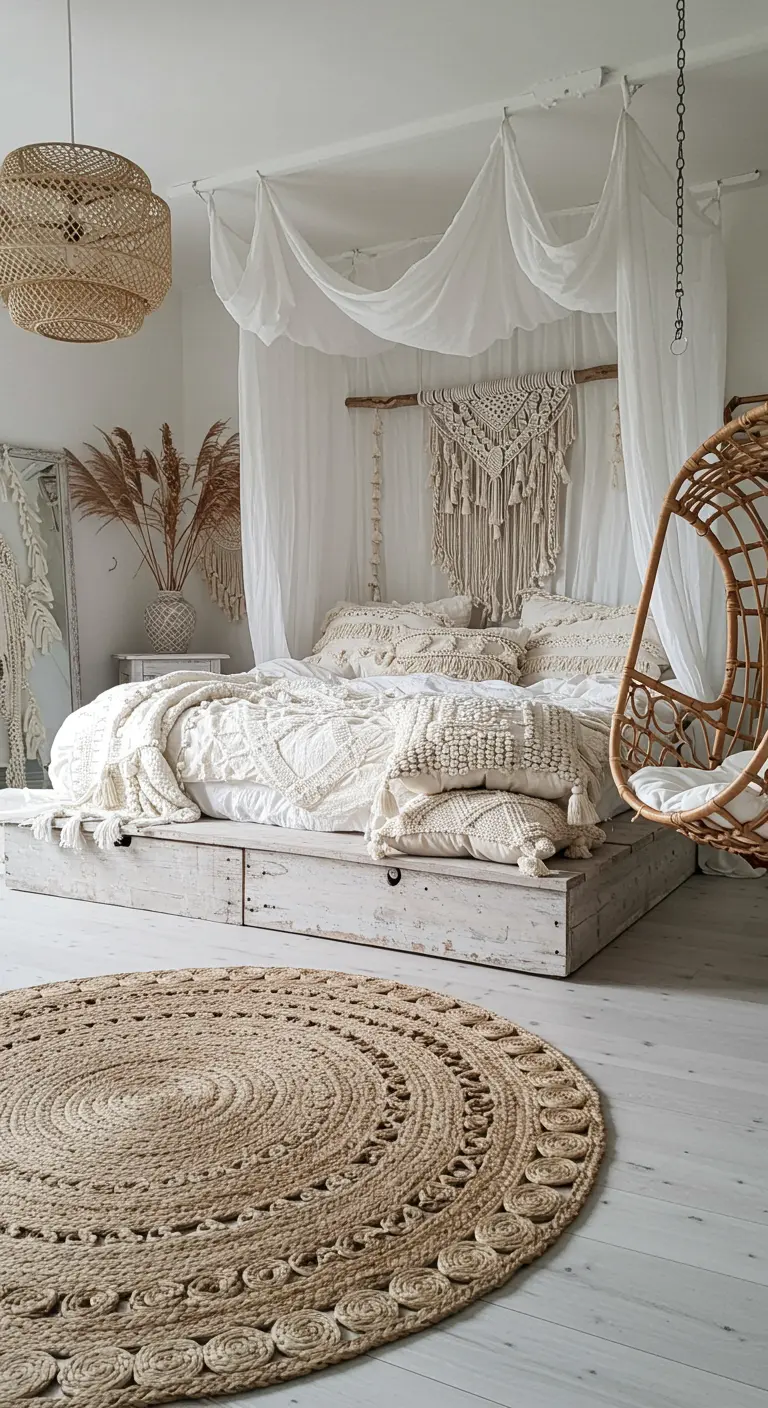
Achieve a relaxed, bohemian look by layering multiple natural textures in shades of white and cream.
Drape soft, gauzy fabric to create a simple bed canopy for a romantic, cocooning effect.
Incorporate various woven elements like a macrame wall hanging, a rattan pendant light, and a large jute rug to build the rich, tactile layers essential to boho-chic interiors.
The distressed white finish on the platform bed adds a final touch of rustic, lived-in charm.
24. Maximize Serenity in a Dressing Room
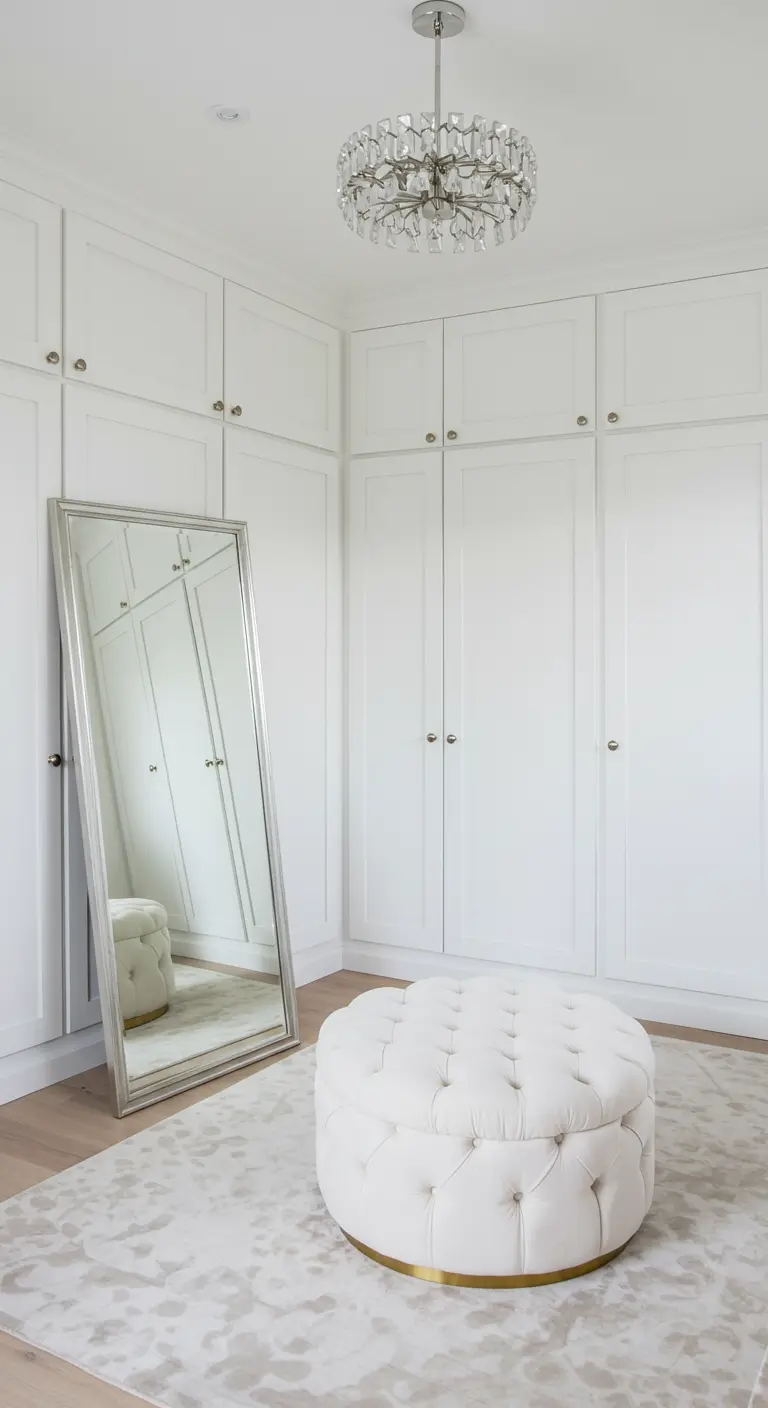
A dressing room or walk-in closet should feel like a calm, organized sanctuary.
Floor-to-ceiling, handle-less white cabinetry creates a seamless, uncluttered backdrop that makes the space feel larger and more serene.
A large, leaning floor mirror is not only practical but also reflects light, a key principle in using mirrors to visually expand small rooms.
Introduce a single, soft furnishing, like this plush tufted ottoman, to provide a touch of glamour and a comfortable spot to sit.
25. Marry Traditional Form with a Modern Palette
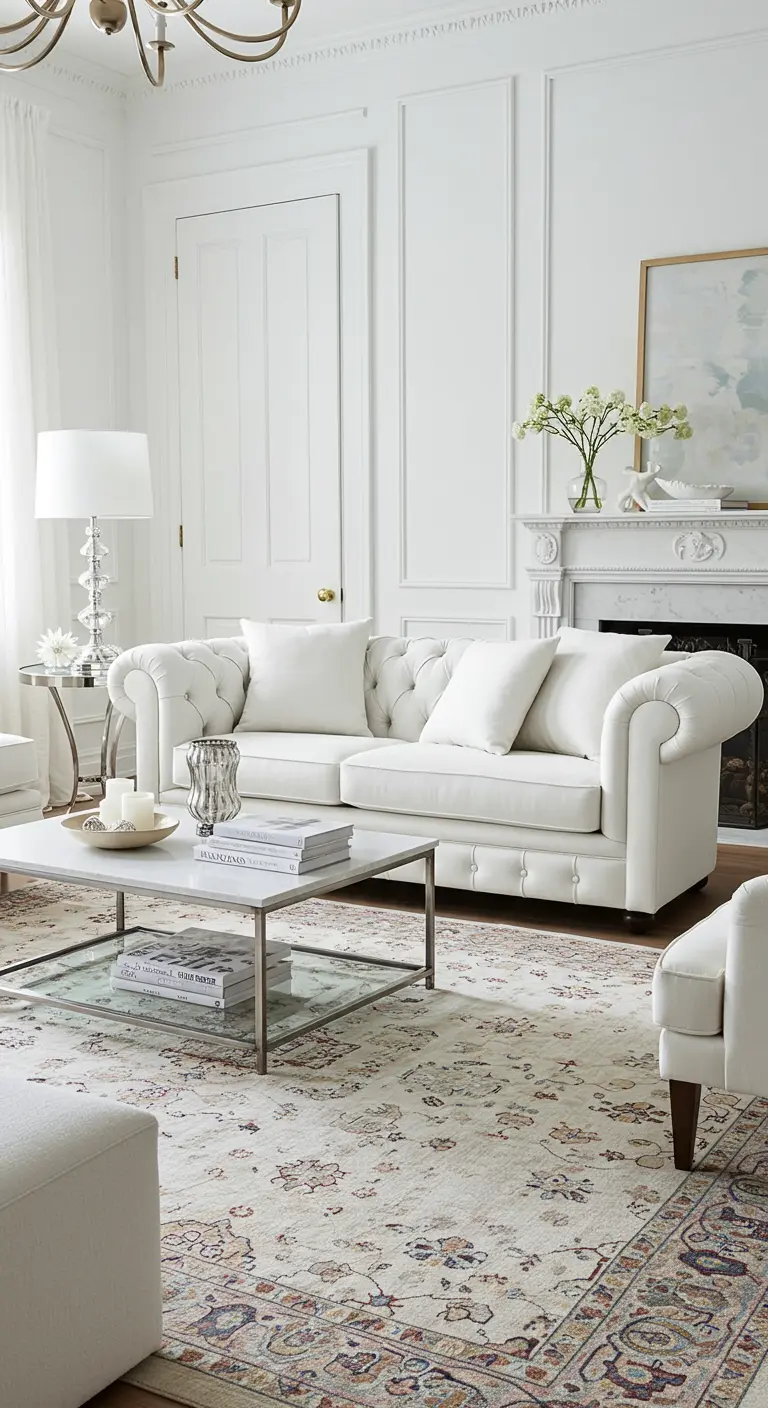
Give traditional architecture and furniture a fresh, contemporary update by committing to a white-on-white palette.
Ornate wall moldings, a classic fireplace, and a Chesterfield sofa are all timeless forms, but rendering them in shades of white makes them feel light and modern, not heavy.
Glass and polished chrome, used for the lamp and coffee table, add a sleek contrast that keeps the look current.
It’s a beautiful example of the elegant neoclassical style made fresh for today.
26. Unify a Library with a Single-Hue Scheme

Transform a collection of books into a stunning, textural backdrop by wrapping them all in white or off-white paper.
This bold design choice turns the focus from the individual titles to the collective form, creating a serene and cohesive architectural feature.
A cozy bouclé or sherpa armchair is the perfect textural complement, its nubby fabric inviting you to sit and stay awhile.
Painting the shelves a soft, warm greige instead of stark white adds depth and sophistication, turning it into an enchanted library space.
27. Embrace Simplicity with Tatami and Floor Cushions
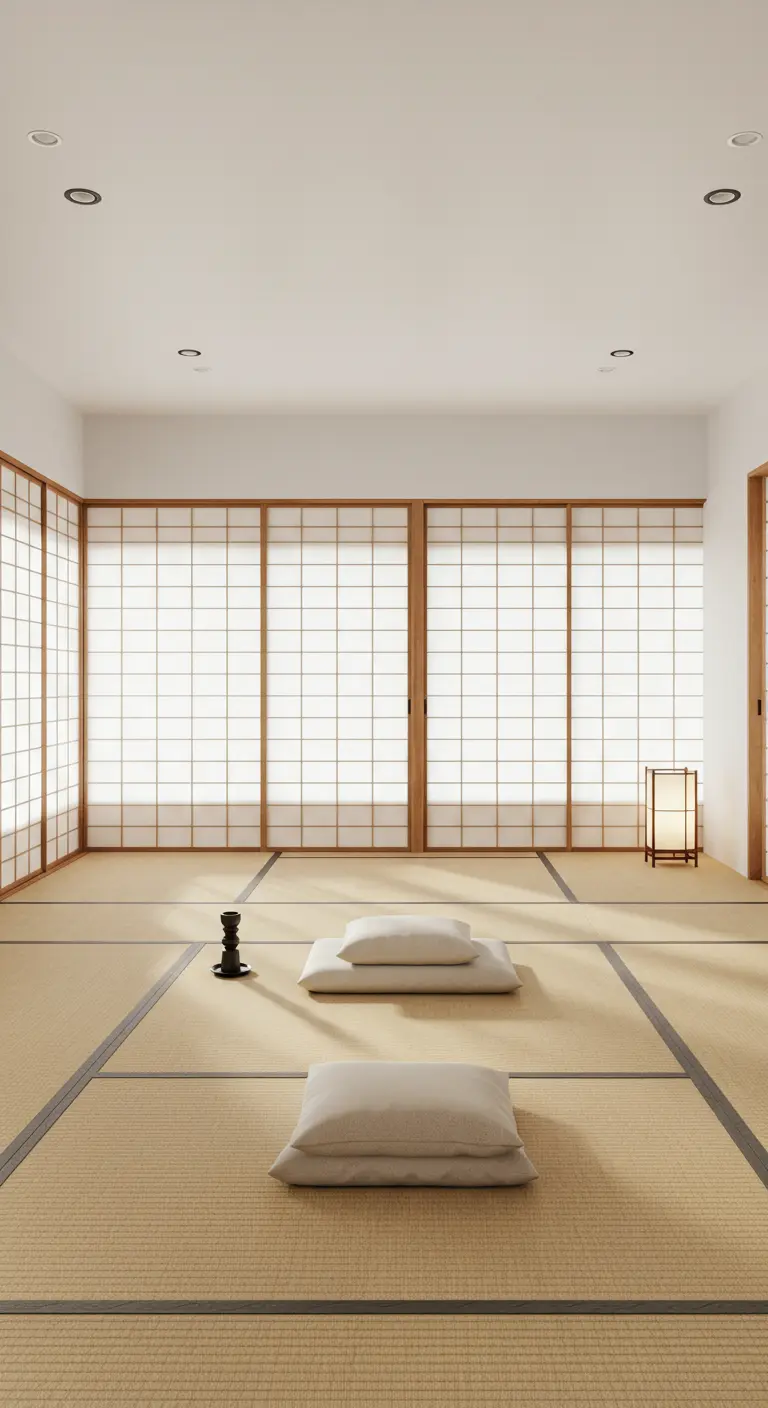
Create a space for quiet contemplation by embracing the core principles of Japanese minimalism.
Tatami mats provide a natural, textural floor covering that is both beautiful and grounding. Their subtle scent and feel underfoot encourage a slower, more mindful state.
Forego traditional furniture in favor of simple floor cushions, which promote a connection to the ground and an uncluttered visual plane.
The only other elements needed are shoji screens for soft light and a single, thoughtfully placed object, key tenets of Japanese-inspired minimalist bedrooms.
28. Erase the Boundary Between Indoors and Out
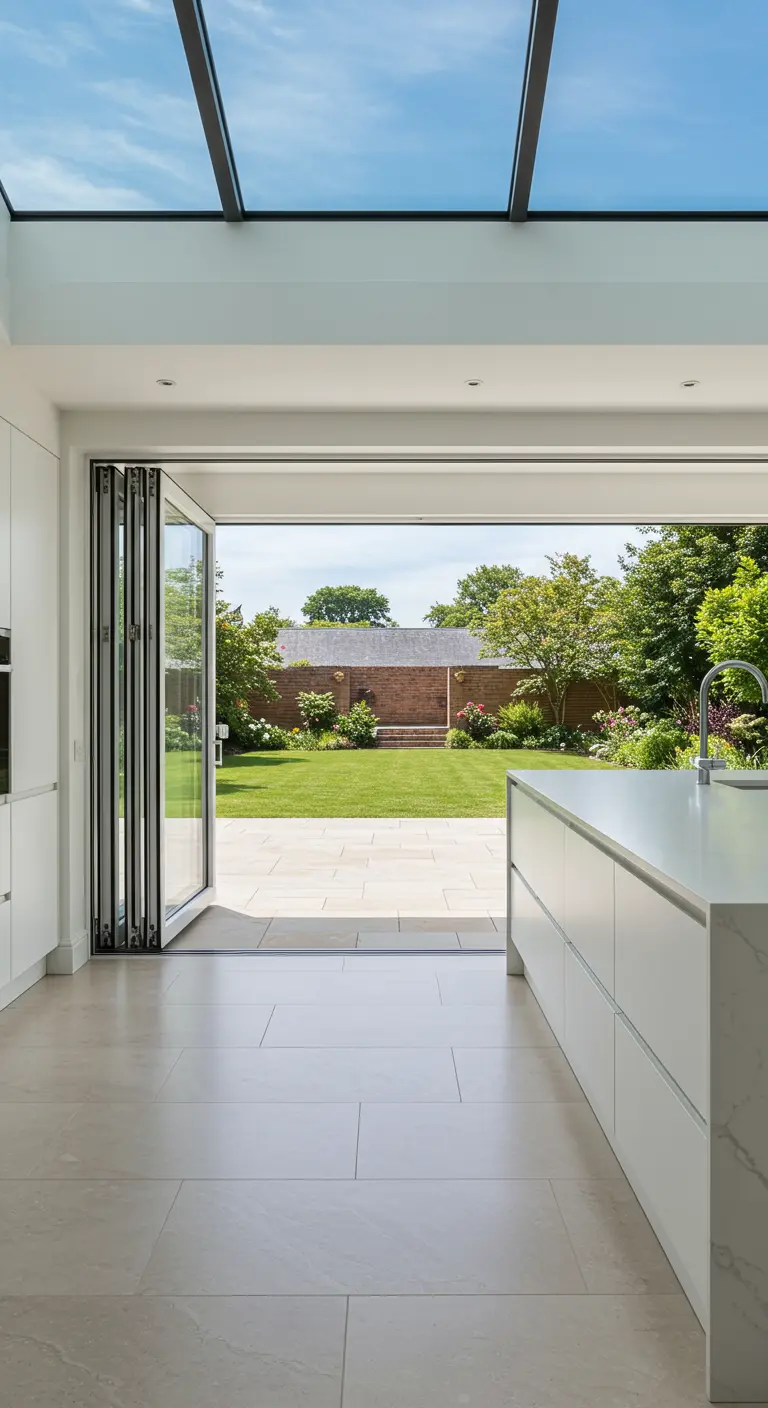
If you are lucky enough to have a garden view, make it the star of your kitchen.
Floor-to-ceiling bi-fold glass doors completely remove the barrier between your interior and the outdoors, flooding the space with light and fresh air.
Keep the interior palette clean and minimal—white handleless cabinets, light stone floors—to ensure the lush greenery of the garden remains the undisputed focal point.
This design creates a seamless flow that makes the kitchen feel infinitely larger, like these stunning rooftop garden nooks.
29. Create a Romantic Canopy with Simple Linen
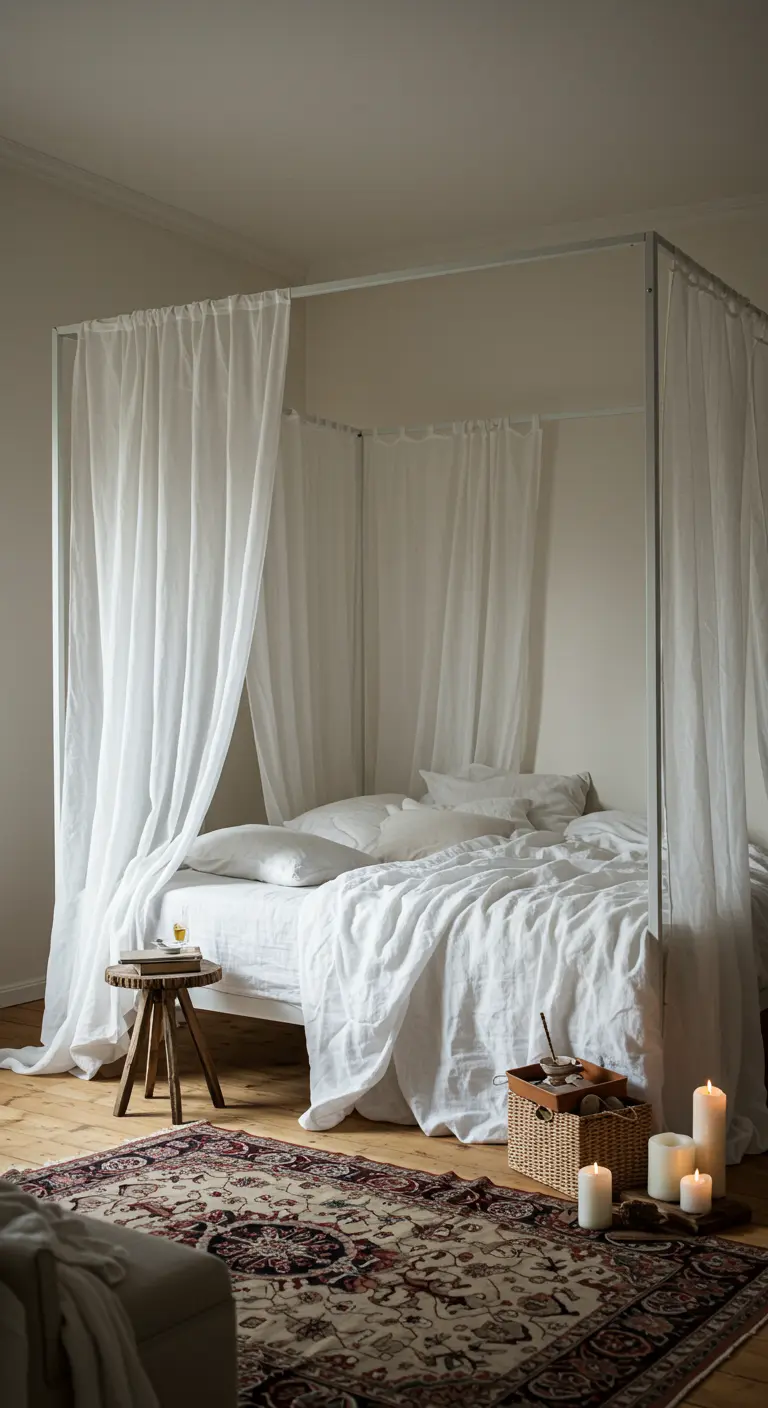
You don’t need a heavy, traditional four-poster bed to create a romantic, canopied effect.
A modern, slim-profile metal frame bed becomes an ethereal retreat when draped with lightweight, semi-sheer white linen curtains.
The fabric softens the frame’s clean lines and creates a cozy, enclosed feeling without blocking light or feeling heavy.
Layer with rumpled linen bedding for an effortlessly chic and inviting look, and complete the ambiance of an enchanting, candlelit retreat.
30. Make a Statement with Sculptural Lighting
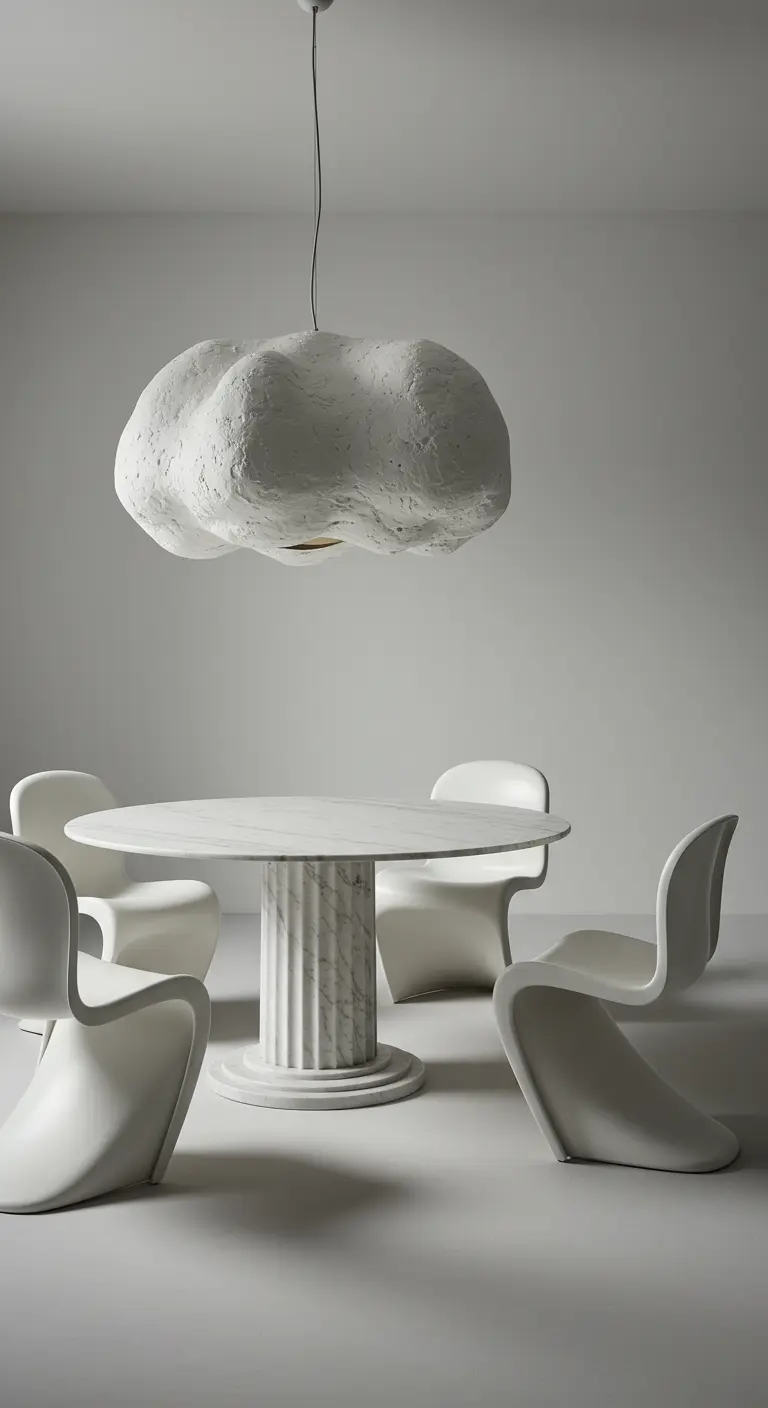
In a minimalist, all-white dining space, let your pendant light be the primary work of art.
This large, cloud-like fixture is made from a textured, plaster-like material, adding an organic, sculptural form that mesmerizes.
It serves as both a light source and a stunning focal point, commanding attention above the simple marble-topped table.
The iconic, curved Panton chairs continue the theme of sculptural forms, ensuring the entire contemporary composition feels curated and intentional.
31. Add Parisian Glamour with Ornate Details
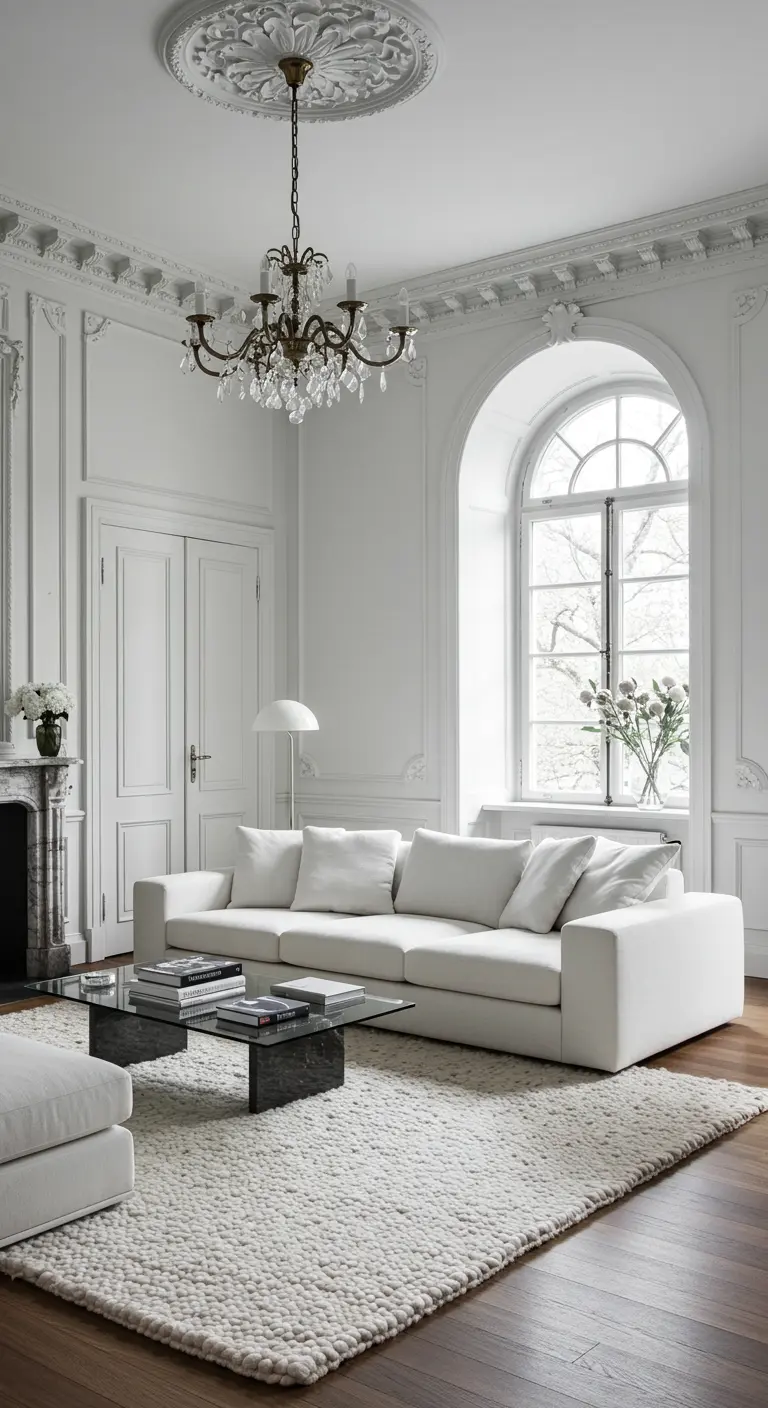
Capture the essence of Parisian elegance by contrasting clean, modern furniture with ornate, classical architecture.
Intricate crown molding and a glittering crystal chandelier provide a dramatic, historic backdrop for a simple, contemporary white sofa.
This juxtaposition is the key to the look—it feels both grand and livable, sophisticated but not stuffy, much like these transitional living spaces.
Keep the color palette restrained to white, wood, and a few metallic accents to let the architectural details and the sparkle of the chandelier truly shine.
